Wernher Magnus Maximilian Freiherr von Braun, 1912-1977
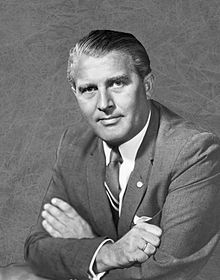
Wernher Magnus Maximilian Freiherr von Braun, 1912-1977

ヴェルナー・マグヌス・マクシミリアン・フライヘル・フォン・ブラウン(Wernher Magnus Maximilian Freiherr von Braun、1912年3月23日 - 1977年6月16日:65歳没)は、ドイツ系アメリカ人の航空宇宙エンジニア[3]、宇宙設計者。ナチス党員、全ゲルマイン親衛隊員であると同時に、ナ チスドイツ におけるロケット技術開発の中心人物であり、アメリカにおけるロケット・宇宙技術のパイオニアであった[4]。
ドイツ軍V兵器の技術総責任者でSS傘下のミッテルバウ=ドーラ計画室室長。ペーパークリップ作戦では、フォート・ブリスでアメリカ陸軍に雇わ れ、その後マーシャル宇宙航空センターの所長を務めた。アメリカ人宇宙飛行士を月に送ったサターンVロケットの主任設計者。
| 1933 Von Braun joined the SS horseback riding school on 1 November 1933 as an SS-Anwärter. He left the following year.:63 In 1940, he joined the SS[24]:47[25] and was given the rank of Untersturmführer in the Allgemeine SS and issued membership number 185,068.:121 In 1947, he gave the U.S. War Department this explanation, - Wernher von Braun. | 1933年
フォン・ブラウンは1933年11月1日、SS乗馬学校にSS-Anwärterとして入校した。1940年、SSに入隊[24]:47[25]、オール
ゲマイネSSのUntersturmführerの階級を与えられ、会員番号1850068を発行された:121
1947年、彼はアメリカ陸軍省にこのように説明している。 |
|
Slave labor "SS General Hans Kammler, who as an engineer had constructed several concentration camps, including Auschwitz, had a reputation for brutality and had originated the idea of using concentration camp prisoners as slave laborers in the rocket program. Arthur Rudolph, chief engineer of the V-2 rocket factory at Peenemünde, endorsed this idea in April 1943 when a labor shortage developed. More people died building the V-2 rockets than were killed by it as a weapon.[41] Von Braun admitted visiting the plant at Mittelwerk on many occasions, and called conditions at the plant "repulsive", but claimed never to have witnessed any deaths or beatings, although it had become clear to him by 1944 that deaths had occurred.[42] He denied ever having visited the Mittelbau-Dora concentration camp itself, where 20,000 died from illness, beatings, hangings, and intolerable working conditions.[43]/ Some prisoners claim von Braun engaged in brutal treatment or approved of it. Guy Morand, a French resistance fighter who was a prisoner in Dora, testified in 1995 that after an apparent sabotage attempt, von Braun ordered a prisoner to be flogged,[44] while Robert Cazabonne, another French prisoner, claimed von Braun stood by as prisoners were hanged by chains suspended by cranes.[44]:123–124 However, these accounts may have been a case of mistaken identity.[45] Former Buchenwald inmate Adam Cabala claims that von Braun went to the concentration camp to pick slave laborers: [... also the German scientists led by Prof. Wernher von Braun were aware of everything daily. As they went along the corridors, they saw the exhaustion of the inmates, their arduous work and their pain. Not one single time did Prof. Wernher von Braun protest against this cruelty during his frequent stays at Dora. Even the aspect of corpses did not touch him: On a small area near the ambulance shed, inmates tortured to death by slave labor and the terror of the overseers were piling up daily. But, Prof. Wernher von Braun passed them so close that he was almost touching the corpses.[46- Fiedermann, Heß, and Jaeger (1993) Das KZ Mittelbau Dora. Ein historischer Abriss, p. 100, Westkreuz Verlag, Berlin]]/ Von Braun later claimed that he was aware of the treatment of prisoners, but felt helpless to change the situation.[47]" - Wernher von Braun. |
奴隷労働 技術者としてアウシュビッツなどの強制収容所を建設したハンス・カムラー親衛隊大将は、残虐なことで知られており、強制収容所の囚人をロケット計画で奴隷 労働者として使用するというアイデアを発案していた。ペーネミュンデのV2ロケット工場の技師長であったアーサー・ルドルフは、人手不足が生じた1943 年4月にこのアイデアを支持した。フォン・ブラウンはミッテルヴェルクの工場を何度も訪れたことを認め、工場の状況を「反吐が出る」と呼んだが、1944 年までに死者が出たことは明らかであったにもかかわらず、死者や殴打を目撃したことはないと主張している[41]。 [フォン・ブラウンは残忍な扱いに関与した、あるいはそれを承認したと主張する囚人もいる[43]。ドーラの囚人であったフランスのレジスタンス闘士ガ イ・モランは1995年に、明らかに破壊工作を試みた後、フォン・ブラウンは囚人に鞭打つことを命じたと証言しており[44]、同じくフランスの囚人ロ ベール・カザボンヌは、囚人がクレーンでつり下げられた鎖で首をつるされたときフォン・ブラウンはそばにいてくれたと主張している[44]:123- 124 しかしこれらの説明は人違いだったかもしれない。元ブッヘンワルド収容所のアダム・カバラがフォン・ブラウンの主張では奴隷労働者を調達しにこの強制収容 所へ行きましたが、フォン・ブラウンは、...、...。[ヴェルナー・フォン・ブラウン教授が率いるドイツの科学者たちは、毎日すべてを知っていた。彼 らは廊下を歩きながら、収容者たちの疲労、彼らの困難な仕事、そして苦痛を目の当たりにした。フォン・ブラウンは、この残酷な環境に対して、一度も抗議す ることなく、ドーラに通い続けた。死体さえも、彼の目に触れることはなかった。救急車小屋の近くの狭い場所には、奴隷労働と監督者の恐怖によって拷問死さ せられた収容者たちが、毎日積み上げられていたのだ。しかし、ヴェルナー・フォン・ブラウン教授は、死体に触れそうなほど近くを通り過ぎた[46- Fiedermann, Heß, and Jaeger (1993) Das KZ Mittelbau Dora. Ein historischer Abriss, p.100, Westkreuz Verlag, Berlin]]/ フォン・ブラウンは後に、捕虜の扱いを知っていたが、状況を変えることはできないと感じたと主張している[47]。 |
| https://en.wikipedia.org/wiki/Wernher_von_Braun |
https://www.deepl.com/ja/translator |
| Wernher Magnus Maximilian
Freiherr von Braun (23 March 1912 – 16 June 1977) was a German-American
aerospace engineer[3] and space architect. He was a member of the Nazi
Party and Allgemeine SS, as well as the leading figure in the
development of rocket technology in Nazi Germany and a pioneer of
rocket and space technology in the United States.[4] As a young man, von Braun worked in Nazi Germany's rocket development program. He helped design and co-developed the V-2 rocket at Peenemünde during World War II. Following the war, he was secretly moved to the United States, along with about 1,600 other German scientists, engineers, and technicians, as part of Operation Paperclip.[5] He worked for the United States Army on an intermediate-range ballistic missile program, and he developed the rockets that launched the United States' first space satellite Explorer 1 in 1958. He worked with Walt Disney on a series of films, which popularized the idea of human space travel in the US and beyond between 1955 and 1957.[6] In 1960, his group was assimilated into NASA, where he served as director of the newly formed Marshall Space Flight Center and as the chief architect of the Saturn V super heavy-lift launch vehicle that propelled the Apollo spacecraft to the Moon.[7][8] In 1967, von Braun was inducted into the National Academy of Engineering, and in 1975, he received the National Medal of Science. Von Braun is widely seen as the "father of space travel",[9] the "father of rocket science"[10] or the "father of the American lunar program".[11] He advocated a human mission to Mars. |
Wernher Magnus Maximilian
Freiherr von Braun、1912年3月23日 -
1977年6月16日)は、ドイツ系アメリカ人の航空宇宙エンジニア[3]、宇宙設計者。ナチス党員、全ゲルマイン親衛隊員であると同時に、ナチスドイツ
におけるロケット技術開発の中心人物であり、アメリカにおけるロケット・宇宙技術のパイオニアであった[4]。 フォン・ブラウンは若い頃、ナチス・ドイツのロケット開発計画に携わった。第二次世界大戦中はペーネミュンデでV-2ロケットの設計と共同開発に携わっ た。戦後、「ペーパークリップ作戦」の一環として、他の約1,600人のドイツ人科学者、エンジニア、技術者とともに密かにアメリカに渡った[5]。アメ リカ陸軍の中距離弾道ミサイル計画に従事し、1958年にアメリカ初の宇宙衛星エクスプローラー1号を打ち上げたロケットの開発を担当した。ウォルト・ ディズニーと共同で一連の映画を制作し、1955年から1957年にかけてアメリカ国内外に有人宇宙旅行のアイデアを普及させた[6]。 1960年、彼のグループはNASAに吸収され、彼は新しく設立されたマーシャル宇宙飛行センターの所長として、またアポロ宇宙船を月に推進するサターン V超重量級ロケットの主任設計者として務めた[7][8]。 1967年にフォンブラウンは全米工学アカデミーに入会し、1975年には全米科学メダルを授与された。 フォン・ブラウンは「宇宙旅行の父」[9]、「ロケット科学の父」[10]、「アメリカの月計画の父」として広く知られており、火星への有人探査を提唱し ている[11]。 |
| Wernher von Braun was born on 23
March 1912, in the small town of Wirsitz in the Province of Posen,
Kingdom of Prussia, then German Empire and now Poland.[12] His father, Magnus Freiherr von Braun (1878–1972), was a civil servant and conservative politician; he served as Minister of Agriculture in the federal government during the Weimar Republic. His mother, Emmy von Quistorp (1886–1959), traced her ancestry through both parents to medieval European royalty and was a descendant of Philip III of France, Valdemar I of Denmark, Robert III of Scotland, and Edward III of England.[13][14] Wernher had an older brother, the West German diplomat Sigismund von Braun, who served as Secretary of State in the Foreign Office in the 1970s, and a younger brother, Magnus von Braun, who was a rocket scientist and later a senior executive with Chrysler.[15] The family moved to Berlin, Brandenburg, in 1915, where his father worked at the Ministry of the Interior. After Wernher's Confirmation, his mother gave him a telescope, and he developed a passion for astronomy.[16] Von Braun learned to play both the cello and the piano at an early age and at one time wanted to become a composer. He took lessons from the composer Paul Hindemith. The few pieces of Wernher's youthful compositions that exist are reminiscent of Hindemith's style.[17]: 11 He could play piano pieces of Beethoven and Bach from memory. Beginning in 1925, Wernher attended a boarding school at Ettersburg Castle near Weimar, Free State of Thuringia, where he did not do well in physics and mathematics. There he acquired a copy of Die Rakete zu den Planetenräumen (1923, By Rocket into Planetary Space)[18] by rocket pioneer Hermann Oberth. In 1928, his parents moved him to the Hermann-Lietz-Internat (also a residential school) on the East Frisian North Sea island of Spiekeroog. Space travel had always fascinated Wernher, and from then on he applied himself to physics and mathematics to pursue his interest in rocket engineering.[19] Opel RAK.1 – World's first public manned flight of a rocket plane on 30 September 1929. The world's first large-scale experimental rocket program was Opel RAK under the leadership of Fritz von Opel and Max Valier during the late 1920s leading to the first manned rocket cars and rocket planes,[20][21] which paved the way for the Nazi era V2 program and US and Soviet activities from 1950 onwards.The Opel RAK program and the spectacular public demonstrations of ground and air vehicles drew large crowds, as well as caused global public excitement as so-called "Rocket Rumble" and had a large long-lasting impact on later spaceflight pioneers, in particular on Wernher von Braun. 16-year old Wernher was so enthusiastic about the public Opel RAK demonstrations, that he constructed his own homemade rocket car, nearly killing himself in the process.[22] and causing a major disruption in a crowded street by detonating the toy wagon to which he had attached fireworks. He was taken into custody by the local police until his father came to get him. The Great Depression put an end to the Opel RAK program and Fritz von Opel left Germany in 1930, emigrating first to the US, later to France and Switzerland. After the break-up of Opel-RAK program, Valier eventually was killed while experimenting with liquid-fueled rockets as means of propulsion in mid-1930, and is considered the first fatality of the dawning space age.[23] In 1930, von Braun attended the Technische Hochschule Berlin, where he joined the Spaceflight Society (Verein für Raumschiffahrt or "VfR"), co-founded by Valier, and worked with Willy Ley in his liquid-fueled rocket motor tests in conjunction with others such as Rolf Engel, Rudolf Nebel, Hermann Oberth or Paul Ehmayr.[24] In spring 1932, he graduated with a diploma in mechanical engineering.[25] His early exposure to rocketry convinced him that the exploration of space would require far more than applications of the current engineering technology. Wanting to learn more about physics, chemistry, and astronomy, von Braun entered the Friedrich-Wilhelm University of Berlin for doctoral studies and graduated with a doctorate in physics in 1934.[26] He also studied at ETH Zürich for a term from June to October 1931.[26] |
ヴェルナー・フォン・ブラウンは1912年3月23日、プロイセン王国
(当時のドイツ帝国、現在のポーランド)のポーゼン州にあるヴィルシッツという小さな町で生まれた[12]。 父のマグヌス・フライヘア・フォン・ブラウン(1878-1972)は公務員で保守派の政治家であり、ワイマール共和国時代の連邦政府で農業大臣を務めて いた。母親のエミー・フォン・クイストルプ(1886-1959)は、両親ともに中世ヨーロッパの王族を祖先とし、フランスのフィリップ3世、デンマーク のヴァルデマル1世、スコットランドのロバート3世、イングランドのエドワード3世の子孫であった[13]。 [13][14] ヴェルナーには、1970年代に外務省国務長官を務めた西ドイツの外交官ジギスムント・フォン・ブラウンの兄と、ロケット科学者で後にクライスラーの上級 役員になったマグナス・フォン・ブラウンの弟がいた[15]。 一家は1915年にブランデンブルク州ベルリンに移り住み、父親は内務省に勤務していた。ヴェルナーの堅信礼の後、母親から望遠鏡を与えられ、天文学に熱 中するようになった[16]。フォン・ブラウンは幼い頃からチェロとピアノを習い、一時は作曲家になりたいと考えていたという。作曲家のパウル・ヒンデ ミットからレッスンを受けた。現存するヴェルナー若かりし頃の数曲はヒンデミットの作風を彷彿とさせるものがある[17]。 11 彼はベートーヴェンやバッハのピアノ曲を記憶して演奏することができた。1925年から、ヴェルンヘルはテューリンゲン自由州ワイマール近郊のエッタース ブルク城の寄宿学校に通うが、物理や数学の成績は良くなかったという。そこで彼はロケットの先駆者ヘルマン・オバースの『Die Rakete zu den Planetenräumen』(1923年、惑星空間へのロケットで)[18]を手に入れた。1928年、両親は彼を東フリジア北海のシュピーケロッグ 島にあるヘルマン・リエッツ・インテルナート(住宅学校でもある)に移した。宇宙旅行は常にヴェルナーに魅了されており、それ以来、彼は物理学と数学に専 念し、ロケット工学への興味を追求するようになった[19]。 オペルRAK.1 - 1929年9月30日、世界初のロケット飛行機による有人飛行を公開。 世界初の大規模なロケット実験計画は、1920年代後半にフリッツ・フォン・オペルとマックス・ヴァリエが主導したオペルRAKで、最初の有人ロケット カーとロケット飛行機につながり[20][21]、ナチス時代のV2計画や1950年以降の米ソの活動への道が開かれることになった。 オペルRAK計画や地上・空中での壮大な公開デモンストレーションは多くの観衆を集め、いわゆる「ロケットランブル」として世界的に世間を騒がせ、後の宇 宙飛行のパイオニア、特にヴェルナー・フォン・ブラウンに長期にわたって大きな影響を及ぼした。16歳のウェルナーは、オペルRAKの公開デモンストレー ションに熱中し、自作のロケットカーを製作したが、その過程で自殺しそうになり[22]、花火を取り付けたおもちゃのワゴンを爆発させ、雑踏を大きく混乱 させることになった。父親が迎えに来るまで地元警察に保護された。世界恐慌により、オペルRAKプログラムは終了し、フリッツ・フォン・オペルは1930 年にドイツを離れ、最初はアメリカへ、後にフランスとスイスへ移住した。オペルRAK計画の解散後、ヴァリエは1930年半ばに液体燃料ロケットを推進手 段として実験中に死亡し、宇宙時代の幕開けの最初の死亡事故とされる[23]。 1930年、フォン・ブラウンはベルリン工科大学に入学し、ヴァリエによって共同設立された宇宙飛行協会(Verein für RaumschiffahrtまたはVfR)に加わり、ウィリー・レイの液体燃料ロケットモーターの実験に、ロルフ・エンゲル、ルドルフ・ネーベル、ヘル マン・オバース、パウル・エマイヤーといった他の人たちと一緒に取り組んだ[24]。1932年の春、機械工学の卒業証書で卒業した[25] 初期のロケットに触れたことにより、宇宙探査には現在の工学技術の応用よりはるかに多くが必要となると確信することになった。物理学、化学、天文学につい てもっと学びたいと思ったフォン・ブラウンは、博士課程のためにベルリンのフリードリヒ・ヴィルヘルム大学に入学し、1934年に物理学の博士号を取得し た[26]。 彼はまた1931年6月から10月の間、チューリッヒ工科大学に留学している[26]。 |
| In 1930, von Braun attended a
presentation given by Auguste Piccard. After the talk, the young
student approached the famous pioneer of high-altitude balloon flight,
and stated to him: "You know, I plan on traveling to the Moon at some
time." Piccard is said to have responded with encouraging words.[27] Von Braun was greatly influenced by Oberth, of whom he said: Hermann Oberth was the first who, when thinking about the possibility of spaceships, grabbed a slide-rule and presented mathematically analyzed concepts and designs ... I, myself, owe to him not only the guiding-star of my life, but also my first contact with the theoretical and practical aspects of rocketry and space travel. A place of honor should be reserved in the history of science and technology for his ground-breaking contributions in the field of astronautics.[28] According to historian Norman Davies, von Braun was able to pursue a career as a rocket scientist in Germany due to a "curious oversight" in the Treaty of Versailles which did not include rocketry in its list of weapons forbidden to Germany.[29] |
1930年、ブラウンはオーギュスト・ピカールの講演会に出席した。講
演の後、若い学生は高高度気球飛行のパイオニアとして有名な彼に近づき、こう言った。"私はいずれ月へ行くつもりです"。ピカールは励ましの言葉を返した
と言われている[27]。 フォン・ブラウンはオバースから大きな影響を受けており、オバースについて次のように語っている。 ヘルマン・オバースは、宇宙船の可能性について考えるとき、スライド・ルーラーを手に取り、数学的に分析した概念と設計を提示した最初の人だっ た......。私自身、彼のおかげで人生の道しるべを得ただけでなく、ロケット工学や宇宙旅行の理論と実践に初めて接することができたのです。科学技術 史において、宇宙工学の分野における彼の画期的な貢献には名誉ある地位が確保されるべきである[28]。 歴史家のノーマン・デイビスによれば、フォン・ブラウンはヴェルサイユ条約でドイツに禁じられた兵器のリストにロケット工学を含めなかったという「不思議 な見落とし」により、ドイツでロケット科学者としてのキャリアを積むことができた[29]。 |
| Nazi Party membership Von Braun had an ambivalent and complex relationship with Nazi Germany.[5] He applied for membership of the Nazi Party on 12 November 1937, and was issued membership number 5,738,692.[30]: 96 Michael J. Neufeld, an author of aerospace history and chief of the Space History Division at the Smithsonian's National Air and Space Museum, wrote that ten years after von Braun obtained his Nazi Party membership, he signed an affidavit for the U.S. Army, though he stated the incorrect year:[30]: 96 In 1939, I was officially demanded to join the National Socialist Party. At this time I was already Technical Director at the Army Rocket Center at Peenemünde (Baltic Sea). The technical work carried out there had, in the meantime, attracted more and more attention in higher levels. Thus, my refusal to join the party would have meant that I would have to abandon the work of my life. Therefore, I decided to join. My membership in the party did not involve any political activity.[30]: 96 It has not been ascertained whether von Braun's error with regard to the year was deliberate or a simple mistake.[30]: 96 Neufeld further wrote: Von Braun, like other Peenemünders, was assigned to the local group in Karlshagen; there is no evidence that he did more than send in his monthly dues. But he is seen in some photographs with the party's swastika pin in his lapel – it was politically useful to demonstrate his membership.[30]: 96 Von Braun's later attitude toward the National Socialist regime of the late 1930s and early 1940s was complex. He said that he had been so influenced by the early Nazi promise of release from the post–World War I economic effects, that his patriotic feelings had increased.[citation needed] In a 1952 memoir article he admitted that, at that time, he "fared relatively rather well under totalitarianism".[30]: 96–97 Yet, he also wrote that "to us, Hitler was still only a pompous fool with a Charlie Chaplin moustache"[31] and that he perceived him as "another Napoleon" who was "wholly without scruples, a godless man who thought himself the only god".[32] |
ナチス党員 フォン・ブラウンはナチス・ドイツと両義的で複雑な関係にあった[5]。 彼は1937年11月12日にナチス党員を申請し、党員番号5,738,692を発行されている[30]: 96。 航空宇宙史の著者であり、スミソニアン航空宇宙博物館の宇宙史部門のチーフであるマイケル・J・ノイフェルドは、フォン・ブラウンがナチ党員資格を得た 10年後に、誤った年を記載したものの、アメリカ陸軍の宣誓供述書にサインしたと書いている[30]: 96。 1939年、私は正式に国家社会党への入党を要求された。このとき、私はすでにペーネミュンデ(バルト海)の陸軍ロケットセンターで技術責任者をしてい た。そこで行われていた技術的な仕事は、その間、上層部でますます注目されるようになっていた。したがって、私が入党を拒否すれば、人生の仕事を放棄しな ければならないことになる。そこで、私は入党することにした。私の党員としての活動は、いかなる政治的活動も伴わなかった[30]: 96。 フォン・ブラウンの年号に関する誤りが意図的なものであったのか、それとも単なる間違いであったのかは確認されていない[30]: 96 Neufeldはさらに次のように書いている。 フォン・ブラウンは、他のペーネマンダーと同様に、カールスハーゲンの地方グループに配属されていた。しかし、彼は党の鉤十字のピンを襟につけている写真 もあり、党員であることを示すのに政治的に有効であった[30]: 96。 1930年代後半から1940年代前半の国家社会主義政権に対するフォン・ブラウンのその後の態度は複雑であった。彼は、第一次世界大戦後の経済的影響か らの解放という初期のナチスの約束に影響され、愛国心が高まったと述べている[citation needed] 1952年の回想録の記事で、当時は「全体主義の下では比較的うまくいっていた」ことを認めている[30]: 9697。 [30]: 96-97しかし、彼はまた「我々にとってヒトラーはまだチャーリー・チャップリンの口髭をつけた尊大な愚か者に過ぎなかった」[31]と書いており、彼 を「完全に無節操で、自分を唯一の神と考える無神論者」である「別のナポレオン」として認識していると書いている[32]。 |
| Membership in the Allgemeine-SS Von Braun joined the SS horseback riding school on 1 November 1933 as an SS-Anwärter. He left the following year.[33]: 63 In 1940, von Braun joined the SS[34]: 47 [35] and was given the rank of Untersturmführer in the Allgemeine-SS and issued membership number 185,068.: 121 In 1947, he gave the U.S. War Department this explanation: In spring 1940, one SS-Standartenführer (SS-Colonel) Müller from Greifswald, a bigger town in the vicinity of Peenemünde, looked me up in my office ... and told me that Reichsführer-SS Himmler had sent him with the order to urge me to join the SS. I told him I was so busy with my rocket work that I had no time to spare for any political activity. He then told me, that ... the SS would cost me no time at all. I would be awarded the rank of a[n] "Untersturmfuehrer" (lieutenant) and it were [sic] a very definite desire of Himmler that I attend his invitation to join. I asked Müller to give me some time for reflection. He agreed. Realizing that the matter was of highly political significance for the relation between the SS and the Army, I called immediately on my military superior, Dr. Dornberger. He informed me that the SS had for a long time been trying to get their "finger in the pie" of the rocket work. I asked him what to do. He replied on the spot that if I wanted to continue our mutual work, I had no alternative but to join.[36] When shown a picture of himself standing behind Himmler, von Braun claimed to have worn the SS uniform only that one time,[37] but in 2002 a former SS officer at Peenemünde told the BBC that von Braun had regularly worn the SS uniform to official meetings. He began as an Untersturmführer (Second lieutenant) and was promoted three times by Himmler, the last time in June 1943 to SS-Sturmbannführer (Major). Von Braun later claimed that these were simply technical promotions received each year regularly by mail.[38] |
アルゲマイネ親衛隊への入隊 フォン・ブラウンは1933年11月1日、SS乗馬学校にSS-Anwärterとして入校した。翌年には退役した[33]: 63 1940年、フォン・ブラウンはSSに入隊した[34]。 47 [35]、オールゲマイネSSのウンタースツルムフューラーの階級を与えられ、会員番号185,068を発行された: 121 1947年に、彼はアメリカ陸軍省にこのように説明している。 1940年春、ペーネミュンデ近郊の大きな町グライフスヴァルトから来た一人のSS親衛隊長(SS大佐)ミュラーが、私の事務所に私を訪ねてきて...ヒ ムラー親衛隊長から、私にSSに入るよう促す指令が来たと告げました。私はロケットの仕事で忙しく、政治的な活動に割く時間はないと言いました。すると彼 は、...SSに入れば何の時間もかからないと言ったのです。私は「中尉」の階級を与えられるし、ヒムラーの非常に明確な希望として、私が彼の招待に参加 することができるのだ、と。 私は、ミュラーに考える時間を与えてくれるように頼みました。彼は承諾してくれました。 私は、この問題がSSと陸軍の関係にとってきわめて政治的に重要であることを理解していたので、すぐに軍の上司であるドーンベルガー博士に電話をかけた。 彼は、SSが長い間、ロケットの仕事の「パイ」に指を入れようとしていたことを私に告げた。私は彼にどうしたらいいかと尋ねた。彼はその場で、もし私がお 互いの仕事を続けたいのであれば、参加する以外の選択肢はないと答えた[36]。 ヒムラーの後ろに立っている写真を見せられたフォン・ブラウンは、SSの制服を着たのはその一度きりだと主張したが[37]、2002年にペーネミュンデ の元SS士官がBBCに語ったところによると、フォン・ブラウンは公式の会合に定期的にSSの制服を着ていたとのことである。彼はウンターシュトゥルム フューラー(少尉)から始まり、ヒムラーによって3回昇進し、最後は1943年6月にSSシュトゥルムバンフューラー(少佐)に昇進している。フォン・ブ ラウンは後に、これらは毎年定期的に郵便で送られてくる技術的な昇進に過ぎないと主張した[38]。 |
| Work under Nazi regime First rank, from left to right, General Dr. Walter Dornberger (partially hidden), General Friedrich Olbricht (with Knight's Cross), Major Heinz Brandt, and Wernher von Braun (in civilian dress) at Peenemünde, Province of Pomerania, in March 1941 In 1933, von Braun was working on his creative doctorate when the Nazi Party came to power in a coalition government in Germany; rocketry was almost immediately moved onto the national agenda. An artillery captain, Walter Dornberger, arranged an Ordnance Department research grant for von Braun, who then worked next to Dornberger's existing solid-fuel rocket test site at Kummersdorf.[39] Von Braun was awarded a doctorate in physics[40] (aerospace engineering) on 27 July 1934, from the University of Berlin for a thesis entitled "About Combustion Tests"; his doctoral supervisor was Erich Schumann.[30]: 61 However, this thesis was only the public part of von Braun's work. His actual full thesis, Construction, Theoretical, and Experimental Solution to the Problem of the Liquid Propellant Rocket (dated 16 April 1934) was kept classified by the German army, and was not published until 1960.[41] By the end of 1934, his group had successfully launched two liquid fuel rockets that rose to heights of 2.2 and 3.5 km (2 mi).[42] At the time, Germany was highly interested in American physicist Robert H. Goddard's research. Before 1939, German scientists occasionally contacted Goddard directly with technical questions. Von Braun used Goddard's plans from various journals and incorporated them into the building of the Aggregat (A) series of rockets. The first successful launch of an A-4 took place on 3 October 1942.[43] The A-4 rocket would become well known as the V-2.[44] In 1963, von Braun reflected on the history of rocketry, and said of Goddard's work: "His rockets ... may have been rather crude by present-day standards, but they blazed the trail and incorporated many features used in our most modern rockets and space vehicles."[26] Goddard confirmed his work was used by von Braun in 1944, shortly before the Nazis began firing V-2s at England. A V-2 crashed in Sweden and some parts were sent to an Annapolis lab where Goddard was doing research for the Navy. If this was the so-called Bäckebo Bomb, it had been procured by the British in exchange for Spitfires; Annapolis would have received some parts from them. Goddard is reported to have recognized components he had invented, and inferred that his brainchild had been turned into a weapon.[45] Later, von Braun would comment: "I have very deep and sincere regret for the victims of the V-2 rockets, but there were victims on both sides ... A war is a war, and when my country is at war, my duty is to help win that war."[46] In response to Goddard's claims, von Braun said "at no time in Germany did I or any of my associates ever see a Goddard patent". This was independently confirmed. He wrote that claims about his lifting Goddard's work were the furthest from the truth, noting that Goddard's paper "A Method of Reaching Extreme Altitudes", which was studied by von Braun and Oberth, lacked the specificity of liquid-fuel experimentation with rockets. It was also confirmed that he was responsible for an estimated 20 patentable innovations related to rocketry, as well as receiving U.S. patents after the war concerning the advancement of rocketry. Documented accounts also stated he provided solutions to a host of aerospace engineering problems in the 1950s and 1960s.[47] On 22 December 1942, Adolf Hitler ordered the production of the A-4 as a "vengeance weapon", and the Peenemünde group developed it to target London. Following von Braun's 7 July 1943 presentation of a color movie showing an A-4 taking off, Hitler was so enthusiastic that he personally made von Braun a professor shortly thereafter.[48] By that time, the British and Soviet intelligence agencies were aware of the rocket program and von Braun's team at Peenemünde, based on the intelligence provided by the Polish underground Home Army. Over the nights of 17–18 August 1943, RAF Bomber Command's Operation Hydra dispatched raids on the Peenemünde camp consisting of 596 aircraft, and dropped 1,800 tons of explosives.[49] The facility was salvaged and most of the engineering team remained unharmed; however, the raids killed von Braun's engine designer Walter Thiel and Chief Engineer Walther, and the rocket program was delayed.[50][51] See also: Bombing of Peenemünde in World War II The first combat A-4, renamed the V-2 (Vergeltungswaffe 2 "Retaliation/Vengeance Weapon 2") for propaganda purposes, was launched toward England on 7 September 1944, only 21 months after the project had been officially commissioned.[52] Satirist Mort Sahl has been credited with mocking von Braun by saying "I aim at the stars, but sometimes I hit London."[53] |
ナチス政権下での仕事 1941年3月、ポメラニア州ペーネミュンデにて、左からワルター・ドーンベルガー将軍(一部伏せ字)、フリードリヒ・オルブリヒト将軍(騎士十字章)、 ハインツ・ブラント少佐、ヴェルナー・フォン・ブラウン(私服姿)の一等兵。 1933年、ブラウンは独創的な博士号取得を目指していたが、ドイツでナチス連立政権が誕生し、ロケット工学が国家的な課題として取り上げられることに なった。砲兵隊長のワルター・ドーンベルガーはフォン・ブラウンのために兵器局の研究助成金を手配し、フォン・ブラウンはドーンベルガーがクマースドルフ に所有していた固体燃料ロケットの実験場の隣で働くことになった[39]。 フォン・ブラウンは1934年7月27日に「燃焼試験について」という論文でベルリン大学から物理学[40](航空宇宙工学)の博士号を授与され、彼の博 士課程の監督はエーリッヒ・シューマンだった[30]: 61 しかしこの論文はフォン・ブラウンの仕事の公的部分に過ぎなかった。1934年4月16日付の彼の論文『液体推進剤ロケットの問題に対する構造、理論、実 験的解決』はドイツ軍によって機密扱いされ、1960年まで出版されなかった[41]。1934年末までに、彼のグループは2つの液体燃料ロケットを打ち 上げ、2.2kmと3.5kmという高さまで上昇することに成功した[42]。 当時、ドイツはアメリカの物理学者ロバート・H・ゴダードの研究に強い関心を抱いていた。1939年以前は、ドイツの科学者が技術的な質問でゴダードに直 接コンタクトを取ることがあった。フォン・ブラウンは様々な雑誌からゴダードの設計図を使用し、それをアグリガット(A)シリーズのロケットの製造に取り 入れた。1963年、フォン・ブラウンはロケット工学の歴史を振り返り、ゴダードの仕事についてこう述べた[44]。「彼のロケットは...現代の基準か らすればかなり粗雑だったかもしれないが、道を切り開き、我々の最も現代的なロケットや宇宙船に使われている多くの特徴を取り入れている」[26]。 ゴダードは、ナチスがイギリスに向けてV-2を発射し始める直前の1944年に、自分の作品がフォン・ブラウンによって使用されたことを確認した。V-2 がスウェーデンで墜落し、一部の部品がゴダードが海軍のために研究していたアナポリスの研究所に送られた。これがいわゆるベッケボ爆弾であれば、スピット ファイアと引き換えにイギリスが調達したものであり、アナポリスはそこから部品の一部を受け取ったことになる。ゴダードは自分が発明した部品を認識し、自 分の発明が兵器に転用されたことを推察したとされる[45] 後にフォン・ブラウンはこうコメントしている。「私はV-2ロケットの犠牲者に対して非常に深く、心から残念に思っているが、どちら側にも犠牲者がい た......。戦争は戦争であり、私の国が戦争をしているとき、私の義務はその戦争に勝つことを助けることである」[46]と述べている。 ゴダードの主張に対し、フォン・ブラウンは「ドイツでは、私も私の仲間もゴダードの特許を見たことは一度もない」と述べている。これは独自に確認された。 彼は、自分がゴダードの仕事を持ち上げたという主張は真実から最も遠いものであると書き、フォン・ブラウンとオバースが研究したゴダードの論文「A Method of Reaching Extreme Altitudes」には、液体燃料によるロケットの実験という具体性が欠けていることを指摘した。また、ロケットに関する特許性のある発明を推定20件 ほど手がけ、戦後はロケットの進歩に関する米国特許を取得していることも確認された。また、1950年代から1960年代にかけて、多くの航空宇宙工学上 の問題に対して解決策を提供したとする記録もある[47]。 1942年12月22日、アドルフ・ヒトラーは「復讐兵器」としてA-4の製造を命じ、ペーネミュンデ・グループはロンドンを目標にこれを開発した。フォ ン・ブラウンが1943年7月7日にA-4が離陸する様子をカラー動画で発表した後、ヒトラーは非常に熱狂し、その後間もなくフォン・ブラウンを自ら教授 に任命した[48]。 その頃、イギリスとソビエトの情報機関は、ポーランドの地下本国軍から提供された情報に基づいて、ロケット計画とペーネミュンデのフォン・ブラウンのチー ムのことを認識していた。1943年8月17日から18日にかけて、イギリス空軍爆撃機部隊のヒドラ作戦が596機の航空機でペーネミュンデ収容所を空襲 し、1800トンの爆薬を投下した[49]。 施設は引き揚げられ技術陣のほとんどは無事だったが、この空襲でフォン・ブラウンのエンジン設計者ヴァルター・ティールとチーフエンジニアのワルターが死 亡し、ロケット計画は遅滞した[50][51]。 以下も参照。第二次世界大戦におけるペーネミュンデの爆撃 最初の戦闘用A-4は、プロパガンダのためにV-2(Vergeltungswaffe 2 "Retaliation/Vengeance Weapon 2")と名前を変え、プロジェクトが公式に委託されてからわずか21ヶ月後の1944年9月7日にイギリスに向けて発射された[52] 風刺家モート・サールは、「私は星を狙っている、しかし時々ロンドンを打つ」と言ってフォン・ブラウンを嘲ったと信じられている[53]. |
| Experiments with rocket aircraft During 1936, von Braun's rocketry team working at Kummersdorf investigated installing liquid-fuelled rockets in aircraft. Ernst Heinkel enthusiastically supported their efforts, supplying a He-72 and later two He-112s for the experiments. Later in 1936, Erich Warsitz was seconded by the RLM to von Braun and Heinkel, because he had been recognized as one of the most experienced test pilots of the time, and because he also had an extraordinary fund of technical knowledge.[54]: 30 After he familiarized Warsitz with a test-stand run, showing him the corresponding apparatus in the aircraft, he asked: "Are you with us and will you test the rocket in the air? Then, Warsitz, you will be a famous man. And later we will fly to the Moon – with you at the helm!"[54]: 35 In June 1937, at Neuhardenberg (a large field about 70 km (43 mi) east of Berlin, listed as a reserve airfield in the event of war), one of these latter aircraft was flown with its piston engine shut down during flight by Warsitz, at which time it was propelled by von Braun's rocket power alone. Despite a wheels-up landing and the fuselage having been on fire, it proved to official circles that an aircraft could be flown satisfactorily with a back-thrust system through the rear.[54]: 51 At the same time, Hellmuth Walter's experiments into hydrogen peroxide based rockets were leading towards light and simple rockets that appeared well-suited for aircraft installation. Also the firm of Hellmuth Walter at Kiel had been commissioned by the RLM to build a rocket engine for the He-112, so there were two different new rocket motor designs at Neuhardenberg: whereas von Braun's engines were powered by alcohol and liquid oxygen, Walter engines had hydrogen peroxide and calcium permanganate as a catalyst. Von Braun's engines used direct combustion and created fire, the Walter devices used hot vapors from a chemical reaction, but both created thrust and provided high speed.[54]: 41 The subsequent flights with the He-112 used the Walter-rocket instead of von Braun's; it was more reliable, simpler to operate, and safer for the test pilot, Warsitz.[54]: 55 |
ロケット航空機の実験 1936年、フォン・ブラウンのロケット工学チームは、クマーズドルフで液体燃料ロケットを航空機に搭載する研究を行った。エルンスト・ハインケル社は、 実験用にHe-72と後にHe-112を2機提供し、彼らの努力を熱心に支援した。その後、1936年にエーリッヒ・ワルシッツがRLMからフォン・ブラ ウンとハインケルに出向することになった。 30 彼はワルシッツにテスト・スタンド・ランを慣らし、機体の対応する装置を見せた後、こう尋ねた。「君は我々と一緒に、ロケットを空中でテストしてくれるか い?そうすれば、ワルシッツ、君は有名になる。そして後に我々は月へ飛ぶのだ-君が舵をとって!」と言った[54]。 35 1937年6月、ノイハーデンベルク(ベルリンの東約70kmにある大きな野原で、戦争時の予備飛行場として指定されていた)で、後者の1機がワルシッツ によって飛行中にピストンエンジンを止められ、フォン・ブラウンのロケットの力だけで推進される形で飛行された。着陸は車輪が浮き上がり、機体は炎上した が、後方からの推力システムで航空機を満足に飛行させることができることを官界に証明した[54]。 51 同時に、ヘルムート・ワルターの過酸化水素を用いたロケットの実験により、航空機への搭載に適した軽量でシンプルなロケットが開発されていた。フォン・ブ ラウンのエンジンがアルコールと液体酸素を燃料とするのに対し、ウォルターのエンジンは過酸化水素と過マンガン酸カルシウムを触媒とするものであった。 フォン・ブラウンのエンジンは直接燃焼を利用して火を起こし、ウォルターの装置は化学反応による高温の蒸気を利用したが、どちらも推力を生み出し、高速飛 行が可能であった[54]。 41その後のHe-112の飛行では、フォン・ブラウンのロケットではなく、ワルター・ロケットを使用した。この方が信頼性 が高く、操作も簡単で、テストパイロットのワルシッツにとっても安全だった[54]: 55 |
| Slave labor SS General Hans Kammler, who as an engineer had constructed several concentration camps, including Auschwitz, had a reputation for brutality and had originated the idea of using concentration camp prisoners as slave laborers in the rocket program. Arthur Rudolph, chief engineer of the V-2 rocket factory at Peenemünde, endorsed this idea in April 1943 when a labor shortage developed. More people died building the V-2 rockets than were killed by it as a weapon.[55] Von Braun admitted visiting the plant at Mittelwerk on many occasions,[5] and called conditions at the plant "repulsive", but claimed never to have personally witnessed any deaths or beatings, although it had become clear to him by 1944 that deaths had occurred.[56] He denied ever having visited the Mittelbau-Dora concentration camp itself, where 20,000 died from illness, beatings, hangings, and intolerable working conditions.[57] Some prisoners claim von Braun engaged in brutal treatment or approved of it. Guy Morand, a French resistance fighter who was a prisoner in Dora, testified in 1995 that, after an apparent sabotage attempt, von Braun ordered a prisoner to be flogged,[58] while Robert Cazabonne, another French prisoner, claimed von Braun stood by as prisoners were hanged by chains suspended by cranes.[58]: 123–124 However, these accounts may have been a case of mistaken identity.[59] Former Buchenwald inmate Adam Cabala claims that von Braun went to the concentration camp to pick slave laborers: ... also the German scientists led by Prof. Wernher von Braun were aware of everything daily. As they went along the corridors, they saw the exhaustion of the inmates, their arduous work and their pain. Not one single time did Prof. Wernher von Braun protest against this cruelty during his frequent stays at Dora. Even the aspect of corpses did not touch him: On a small area near the ambulance shed, inmates tortured to death by slave labor and the terror of the overseers were piling up daily. But, Prof. Wernher von Braun passed them so close that he was almost touching the corpses.[60] Von Braun later claimed that he was aware of the treatment of prisoners, but felt helpless to change the situation.[61] |
奴隷労働 技術者としてアウシュビッツなどの強制収容所を建設したハンス・カムラー親衛隊大将は、残虐なことで知られており、強制収容所の囚人をロケット計画で奴隷 労働者として使うというアイデアを発案していた。ペーネミュンデのV2ロケット工場の技師長であったアーサー・ルドルフは、人手不足が生じた1943年4 月にこのアイデアを支持した。フォン・ブラウンはミッテルヴェルクの工場を何度も訪問したことを認めており[5]、工場の状況を「反吐が出る」と呼んでい たが、1944年までに死者が出たことは彼にとって明らかであったにもかかわらず、個人的に死や暴行を目撃したことはないと主張していた[56]。 彼は2万人が病気、殴打、絞首刑、耐え難い労働条件で死んでいるミッテルバウ・ドーラ強制収容所を訪れたこと自体否定した[57]。 フォン・ブラウンは残忍な扱いに関与していた、あるいはそれを承認していたと主張する囚人もいる。ドラの囚人であったフランスのレジスタンス闘士ギィ・モ ランは、1995年に、明らかに破壊工作を試みた後、フォン・ブラウンは囚人に鞭打ちを命じたと証言し[58]、同じくフランスの囚人ロベルト・カザボン ヌは、囚人がクレーンで吊るした鎖で首を吊られるのをフォン・ブラウンが傍観したと主張している[58]。 しかし、これらの証言は人違いである可能性も ある[59]。 元ブッヘンヴァルト収容者のアダム・カバラは、フォン・ブラウンは強制収容所に奴隷労働者を採りに行ったと主張している。 ...また、ヴェルナー・フォン・ブラウン教授が率いるドイツの科学者たちは、毎日すべてを知っていた。彼らは廊下を歩きながら、収容者たちの疲労、過酷 な労働、苦痛を目の当たりにした。フォン・ブラウンは、この残酷な環境に対して、一度も抗議することなく、ドーラに通い続けた。死体さえも、彼の目に触れ ることはなかった。救急車小屋の近くの狭い場所には、奴隷労働と監督者の恐怖によって拷問死させられた収容者たちが、毎日積み上げられていたのだ。しか し、ヴェルナー・フォン・ブラウン教授は、死体に触れそうなほど近くでそれらを通り過ぎた[60]。 フォン・ブラウンは後に、囚人たちの扱いに気づいてはいたが、状況を変えることはできないと感じたと主張している[61]。 |
| Arrest and release by the Nazi
regime According to André Sellier, a French historian and survivor of the Mittelbau-Dora concentration camp, Heinrich Himmler had von Braun come to his Feldkommandostelle Hochwald HQ in East Prussia in February 1944.[62] To increase his power-base within the Nazi regime, Himmler was conspiring to use Kammler to gain control of all German armament programs, including the V-2 program at Peenemünde.[17]: 38–40 He therefore recommended that von Braun work more closely with Kammler to solve the problems of the V-2. Von Braun claimed to have replied that the problems were merely technical and he was confident that they would be solved with Dornberger's assistance.[63] Von Braun had been under SD surveillance since October 1943. A secret report stated that he and his colleagues Klaus Riedel and Helmut Gröttrup were said to have expressed regret at an engineer's house one evening in early March 1944 that they were not working on a spaceship[5] and that they felt the war was not going well; this was considered a "defeatist" attitude. A young female dentist who was an SS spy reported their comments. Combined with Himmler's false charges that von Braun and his colleagues were communist sympathizers and had attempted to sabotage the V-2 program, and considering that von Braun regularly piloted his government-provided airplane that might allow him to escape to Britain, this led to their arrest by the Gestapo.[17]: 38–40 The unsuspecting von Braun was detained on 14 March (or 15 March),[64] 1944, and was taken to a Gestapo cell in Stettin (now Szczecin, Poland).[17]: 38–40 where he was held for two weeks without knowing the charges against him.[65] Through Major Hans Georg Klamroth, in charge of the Abwehr for Peenemünde, Dornberger obtained von Braun's conditional release and Albert Speer, Reichsminister for Munitions and War Production, persuaded Hitler to reinstate von Braun so that the V-2 program could continue[5][17]: 38–40 [66] or turn into a "V-4 program" (the Rheinbote as a short range ballistic rocket) which in their view would be impossible without von Braun's leadership.[32] In his memoirs, Speer states Hitler had finally conceded that von Braun was to be "protected from all prosecution as long as he is indispensable, difficult though the general consequences arising from the situation."[67] |
ナチス政権による逮捕と釈放 フランスの歴史家でありミッテルバウ・ドーラ強制収容所の生存者であるアンドレ・セリエによると、ハインリッヒ・ヒムラーは1944年2月にフォン・ブラ ウンを東プロイセンのフェルトコマンドシュテル・ホッフバルト本部に来させた[62]。 ヒムラーはナチ政権内の自分の権力基盤を拡大するために、カムラーを使ってペネミュンデのV-2計画を含むすべてのドイツの軍備計画の支配権を獲得しよう と謀っていたのである[17]。 そこで彼はフォン・ブラウンに対して、V-2の問題を解決するためにカムラーとより緊密に協力するよう勧告した。フォ ン・ブラウンは、問題は単に技術的なものであり、ドーンベルガーの援助があれば解決できると確信していると答えたと主張している[63]。 フォン・ブラウンは1943年10月以来、SDの監視下に置かれていた。秘密報告書によると、彼と同僚のクラウス・リーデルとヘルムート・グレートラップ は、1944年3月初旬のある晩、エンジニアの家で、自分たちが宇宙船に取り組んでいないことを残念に思い[5]、戦争がうまくいっていないと感じていた と言われており、これは「敗北主義」の態度と見なされていた。SSのスパイであった若い女性歯科医が彼らの発言を報告した。フォン・ブラウンらが共産主義者のシンパであり、V-2計画を妨害しようとしたというヒムラー の讒言と、フォン・ブラウンがイギリスへの逃亡を可能にするかもしれない政府支給の飛行機を定期的に操縦していたことを考えると、ゲシュタポによる逮捕に つながった[17]。 38-40 疑心暗鬼になっていたフォン・ブラウンは1944年3月14日(または15日)に拘束され[64]、シュテッチン(現ポーランド、シュチェチン)のゲシュ タポの独房に連行された[17]。 38-40で、彼は自分に対する容疑を知らずに2週間拘束された[65]。 ドルンベルガーはペーネミュンデのAbwehr担当のハンス・ゲオルク・クラムロート少佐を通じてフォン・ブラウンの条件付き釈放を取り付け、軍需・戦争 生産省大臣のアルベルト・スピアはヒトラーにV-2計画を継続できるようにフォン・ブラウンを復職させるよう説得している[5][17]。 シュペーアは 回顧録の中で、ヒトラーが最終的にフォン・ブラウンを「彼が不可欠である限り、状況から生じる一般的な結果が困難であっても、すべての訴追から保護する」 ことを認めたと述べている[32]。 |
| Surrender to the Americans The Soviet Army was about 160 km (100 mi) from Peenemünde in early 1945 when von Braun assembled his planning staff and asked them to decide how and to whom they should surrender. Unwilling to go to the Soviets, von Braun and his staff decided to try to surrender to the Americans. Kammler had ordered relocation of his team to central Germany; however, a conflicting order from an army chief ordered them to join the army and fight. Deciding that Kammler's order was their best bet to defect to the Americans, von Braun fabricated documents and transported 500 of his affiliates to the area around Mittelwerk, where they resumed their work in Bleicherode and surrounding towns after the middle of February 1945. For fear of their documents being destroyed by the SS, von Braun ordered the blueprints to be hidden in an abandoned iron mine in the Harz mountain range near Goslar.[68] The US Counterintelligence Corps managed to unveil the location after lengthy interrogations of von Braun, Walter Dornberger, Bernhard Tessmann and Dieter Huzel and recovered 14 tons of V-2 documents by 15 May 1945, from the British Occupation Zone.[30][69] While on an official trip in March, von Braun suffered a complicated fracture of his left arm and shoulder in a car accident after his driver fell asleep at the wheel. His injuries were serious, but he insisted that his arm be set in a cast so he could leave the hospital. Due to this neglect of the injury he had to be hospitalized again a month later when his bones had to be rebroken and realigned.[68] In early April, as the Allied forces advanced deeper into Germany, Kammler ordered the engineering team, around 450 specialists, to be moved by train into the town of Oberammergau in the Bavarian Alps, where they were closely guarded by the SS with orders to execute the team if they were about to fall into enemy hands. However, von Braun managed to convince SS Major Kummer to order the dispersal of the group into nearby villages so that they would not be an easy target for U.S. bombers.[68] On 29 April 1945, Oberammergau was captured by the Allied forces who seized the majority of the engineering team.[70] Von Braun and several members of the engineering team, including Dornberger, made it to Austria.[71] On 2 May 1945, upon finding an American private from the U.S. 44th Infantry Division, von Braun's brother and fellow rocket engineer, Magnus, approached the soldier on a bicycle, calling out in broken English: "My name is Magnus von Braun. My brother invented the V-2. We want to surrender."[15][72] After the surrender, Wernher von Braun spoke to the press: We knew that we had created a new means of warfare, and the question as to what nation, to what victorious nation we were willing to entrust this brainchild of ours was a moral decision more than anything else. We wanted to see the world spared another conflict such as Germany had just been through, and we felt that only by surrendering such a weapon to people who are guided not by the laws of materialism but by Christianity and humanity could such an assurance to the world be best secured.[73] The American high command was well aware of how important their catch was: von Braun had been at the top of the Black List, the code name for the list of German scientists and engineers targeted for immediate interrogation by U.S. military experts. On 9 June 1945, two days before the originally scheduled handover of the Nordhausen and Bleicherode area in Thuringia to the Soviets, U.S. Army Major Robert B. Staver, Chief of the Jet Propulsion Section of the Research and Intelligence Branch of the U.S. Army Ordnance Corps in London, and Lieuteant Colonel R. L. Williams took von Braun and his department chiefs by Jeep from Garmisch to Munich, from where they were flown to Nordhausen. In the following days, a larger group of rocket engineers, among them Helmut Gröttrup, was evacuated from Bleicherode 40 miles (64 km) southwest to Witzenhausen, a small town in the American Zone.[74] Von Braun was briefly detained at the "Dustbin" interrogation center at Kransberg Castle, where the elite of Nazi Germany's economic, scientific and technological sectors were debriefed by U.S. and British intelligence officials.[75] Initially, he was recruited to the U.S. under a program called Operation Overcast, subsequently known as Operation Paperclip. There is evidence, however, that British intelligence and scientists were the first to interview him in depth, eager to gain information that they knew U.S. officials would deny them.[76][77] The team included the young L.S. Snell, then the leading British rocket engineer, later chief designer of Rolls-Royce Limited and inventor of the Concorde's engines. The specific information the British gleaned remained top secret, both from the Americans and from the other allies.[78] |
アメリカへの降伏 1945年初頭、ソ連軍はペーネミュンデから約160キロ(100マイル)の地点にいた。フォン・ブラウンは企画スタッフを集め、どのように、誰に降伏す べきかを決定するよう依頼した。ソビエトに行くのは嫌なので、フォン・ブラウンと彼のスタッフはアメリカへの降伏を試みることにした。しかし、陸軍大将か ら「軍隊に入り、戦え」という矛盾した命令が出された。フォン・ブラウンは、カムラーからの命令でアメリカに亡命するのが最善と判断し、書類を捏造して 500人の仲間をミッテルヴェルク周辺に移送し、1945年2月中旬以降ブライヒェローデや周辺の街で仕事を再開させた。フォン・ブラウンは親衛隊による 文書の破壊を恐れて、設計図をゴスラー近郊のハルツ山脈の廃坑に隠すよう命じた[68]。アメリカの防諜部隊はフォン・ブラウン、ワルター・ドーンベル ガー、ベルンハルト・テスマン、ディーター・フゼルを長時間尋問してその場所を明らかにし、イギリス占領区から1945年5月15日までに14トンのV2 書類を回収することに成功した[30][69]。 3月に公式出張中のフォン・ブラウンは、運転手の居眠り運転による交通事故で左腕と肩の複雑骨折を負った。彼の怪我は深刻だったが、彼は退院できるように 腕をギブスで固定することにこだわった。この怪我を放置したため、1ヶ月後に再び入院し、骨の再骨折と再調整をしなければならなくなった[68]。 4月初旬、連合軍がドイツに深く進攻すると、カンムラーは技術者チーム約450名を列車でバイエルン・アルプスのオーバーランメルガウの町に移動するよう 命じ、そこでSSが厳重に監視し、敵の手に落ちそうになったらチームを処刑するよう命じた。しかし、フォン・ブラウンは親衛隊のクマー少佐を説得し、彼ら がアメリカの爆撃機の容易な標的とならないように、グループを近くの村に分散させることを命じた[68]。1945年4月29日に、オーベルマーガウは連 合軍に占領され、エンジニアチームの大半を押収された[70]。 1945年5月2日、フォン・ブラウンとドーンベルガーを含む技術チームの数名はオーストリアにたどり着いた[71]。フォン・ブラウンの弟でロケット技 術者仲間のマグヌスは、アメリカ第44歩兵師団のアメリカ兵を見つけると、自転車に乗った兵士に近づき、壊れた英語で呼び掛けた。「私の名前はマグヌス・ フォン・ブラウンです。私の名前はマグヌス・フォン・ブラウンです。私の兄はV-2を発明しました。私たちは降伏したいのです」[15][72] 降伏後、ヴェルナー・フォン・ブラウンは報道陣にこう語っている。 私たちは新しい戦争手段を生み出したことを知っていました。そして、どの国が、どの戦勝国が、私たちのこの頭脳を喜んで託すのかという問題は、何よりも道 徳的な決断でした。私たちは、ドイツが経験したばかりのような紛争を世界が再び免れることを望んでおり、物質主義の法則ではなく、キリスト教と人間性に導 かれた人々にこのような兵器を明け渡すことによってのみ、世界に対するそのような保証が最もよく確保されると感じていた[73]。 フォン・ブラウンは、ブラックリスト(ドイツの科学者や技術者を集め、米軍の専門家が直ちに尋問するためのコードネーム)の筆頭に挙げられていたのであ る。1945年6月9日、当初予定されていたチューリンゲン州ノルトハウゼンとブライヒェローデ地区のソビエト軍への引き渡しの2日前、ロンドンの米陸軍 兵器軍団研究・情報部ジェット推進課長ロバート B. スタバー大佐とR L. ウィリアムズ中佐がフォン ブラウンと彼の部門の責任者をジープでガルミッシュからミュンヘンに運び、そこからノルトハウゼンへ飛行機で移動させた。翌日、ヘルムート・グレトルップ を含むロケット技術者の大集団は、ブライヒェローデから南西40マイル(64km)のアメリカンゾーンにある小さな町ヴィツェンハウゼンへ避難した [74]。 フォン・ブラウンは、ナチス・ドイツの経済、科学、技術部門のエリートが米英の情報当局から報告を受けるクランスベルク城の「ダストビン」尋問センターに 短期間拘束された[75]。当初、彼はオーバーキャスト作戦、その後ペーパークリップ作戦と呼ばれるプログラムに基づいてアメリカに採用された。しかし、 英国の諜報機関や科学者が、米国当局が否定するとわかっている情報を得ようと、最初に彼に詳細な聞き取りを行ったという証拠がある[76][77]。その チームには、当時英国のロケット工学の第一人者で、後にロールス・ロイス社の主任設計者となりコンコルドのエンジンを発明した若きL・S・スネルがいた。 イギリスが得た具体的な情報は、アメリカからも他の同盟国からもトップシークレットのままであった[78]。 |
| U.S. Army career On 20 June 1945, U.S. Secretary of State Edward Stettinius Jr. approved the transfer of von Braun and his specialists to the United States as one of his last acts in office; however, this was not announced to the public until 1 October 1945.[79] The first seven technicians arrived in the United States at New Castle Army Air Field, just south of Wilmington, Delaware, on 20 September 1945. They were then flown to Boston, Massachusetts, and taken by boat to the Army Intelligence Service post at Fort Strong in Boston Harbor. Later, with the exception of von Braun, the men were transferred to Aberdeen Proving Ground in Maryland to sort out the Peenemünde documents, enabling the scientists to continue their rocketry experiments.[80] Finally, von Braun and his remaining Peenemünde staff (see List of German rocket scientists in the United States) were transferred to their new home at Fort Bliss, a large Army installation just north of El Paso, Texas. Von Braun later wrote that he found it hard to develop a "genuine emotional attachment" to his new surroundings.[81] His chief design engineer Walther Reidel became the subject of a December 1946 article "German Scientist Says American Cooking Tasteless; Dislikes Rubberized Chicken", exposing the presence of von Braun's team in the country and drawing criticism from Albert Einstein and John Dingell.[81] Requests to improve their living conditions such as laying linoleum over their cracked wood flooring were rejected.[81] Von Braun remarked, "at Peenemünde we had been coddled, here you were counting pennies".[81] Whereas von Braun had thousands of engineers who answered to him at Peenemünde, he was now subordinate to "pimply" 26-year-old Jim Hamill, an Army major who possessed only an undergraduate degree in engineering.[81] His loyal Germans still addressed him as "Herr Professor," but Hamill addressed him as "Wernher" and never responded to von Braun's request for more materials. Every proposal for new rocket ideas was dismissed.[81] While at Fort Bliss, they trained military, industrial, and university personnel in the intricacies of rockets and guided missiles. As part of the Hermes project, they helped refurbish, assemble, and launch a number of V-2s that had been shipped from Allied-occupied Germany to the White Sands Proving Ground in New Mexico. They also continued to study the future potential of rockets for military and research applications. Since they were not permitted to leave Fort Bliss without military escort, von Braun and his colleagues began to refer to themselves only half-jokingly as "PoPs" – "Prisoners of Peace".[82] In 1950, at the start of the Korean War, von Braun and his team were transferred to Huntsville, Alabama, his home for the next 20 years. Between 1952 and 1956,[83] von Braun led the Army's rocket development team at Redstone Arsenal, resulting in the Redstone rocket, which was used for the first live nuclear ballistic missile tests conducted by the United States. He personally witnessed this historic launch and detonation.[84] Work on the Redstone led to development of the first high-precision inertial guidance system on the Redstone rocket.[85] As director of the Development Operations Division of the Army Ballistic Missile Agency, von Braun, with his team, then developed the Jupiter-C, a modified Redstone rocket.[86] The Jupiter-C was the basis for the Juno I rocket that successfully launched the West's first satellite, Explorer 1, on 31 January 1958. This event signaled the birth of America's space program.[87] |
米軍での経歴 1945年6月20日、アメリカ国務長官エドワード・ステティニアス・ジュニアは、フォン・ブラウンとその専門家のアメリカへの移送を任期最後の行為とし て承認したが、このことが公に発表されたのは1945年10月1日になってからであった[79]。 最初の7人の技術者は1945年9月20日にデラウェア州ウィルミントンの南にあるニューキャッスル陸軍飛行場に米国に到着した。その後、マサチューセッ ツ州ボストンに空輸され、ボストン港のフォート・ストロングにある陸軍情報局の拠点に船で運ばれた。その後、フォン・ブラウンを除き、彼らはメリーランド 州のアバディーン実験場に移送され、ペーネミュンデの文書を整理し、科学者がロケット実験を続けられるようにした[80]。 最終的にフォン・ブラウンと残りのペーネミュンデのスタッフ(アメリカにおけるドイツのロケット科学者のリストを参照)は、テキサス州エルパソのすぐ北に ある大規模な陸軍施設、フォートブリスに新居を移された。フォン・ブラウンは後に、新しい環境に対して「純粋な感情移入」をすることが難しいと書いている [81]。設計技師長のワルター・ライデルは、1946年12月の記事「ドイツの科学者はアメリカの料理は味気ないと言い、ゴム引き鶏を嫌う」で話題にな り、フォン・ブラウンチームのアメリカでの存在を暴露して、アルベルト・アインシュタインやジョン・ディンゲルの批判を浴びることになった[81]。 [フォン・ブラウンは「ペーネミュンデでは我々は甘やかされていたが、ここでは小銭を数えていた」と発言している[81]。ペーネミュンデでは何千人もの エンジニアが彼に仕えていたが、彼は26歳の「ぴんぴん」した、工学部を卒業しただけの陸軍少佐ジム・ハミルトンに仕えることになった[81]。忠実なド イツ人からは「教授様」として呼ばれていたが、ハミルトンは「ウェルナー」として彼を呼び、さらに材料を要求しても決して応えてはくれなかった。新しいロ ケットのアイデアに関する提案は全て却下された[81]。 フォートブリスにいる間、彼らは軍、産業界、大学関係者にロケットと誘導ミサイルの複雑な技術について訓練を行った。ヘルメス計画の一環として、連合国占 領下のドイツからニューメキシコ州のホワイトサンズ実験場に輸送された多数のV-2の改修、組み立て、打ち上げを手伝った。また、ロケットの将来的な軍 事・研究用途への可能性についても研究を続けた。フォン・ブラウンと彼の同僚たちは、軍の護衛なしにフォートブリスを離れることが許されなかったため、半 ば冗談で自分たちを「PoPs」-「Prisoners of Peace」-と呼ぶようになった[82]。 1950年、朝鮮戦争が始まると、フォン・ブラウンと彼のチームはアラバマ州ハンツビルに移され、その後20年間は彼の家となった。1952年から 1956年にかけて、フォン・ブラウンはレッドストーン工廠で陸軍のロケット開発チームを率い、レッドストーンロケットを完成させ、このロケットはアメリ カ合衆国が行った最初の核弾道ミサイルの実戦実験に使用された。彼はこの歴史的な発射と爆発に自ら立ち会った[84]。レッドストーンに関する仕事は、 レッドストーン・ロケットの最初の高精度な慣性誘導システムの開発につながった[85]。 フォン・ブラウンは陸軍弾道ミサイル庁の開発業務課長として、彼のチームと共にレッドストーンロケットを改良したジュピターCを開発した[86]。ジュピ ターCはジュノーIロケットの基礎となり、1958年1月31日に西側初の衛星エクスプローラ1の打ち上げに成功した。この出来事は、アメリカの宇宙開発 計画の誕生を告げるものであった[87]。 |
| Popular concepts for a human
presence in space Repeating the pattern he had established during his earlier career in Germany, von Braun – while directing military rocket development in the real world – continued to entertain his engineer-scientist's dream of a future in which rockets would be used for space exploration. However, he was no longer at risk of being sacked – as American public opinion of Germans began to recover, von Braun found himself increasingly in a position to popularize his ideas. The 14 May 1950 headline of The Huntsville Times ("Dr. von Braun Says Rocket Flights Possible to Moon") might have marked the beginning of these efforts. Von Braun's ideas rode a publicity wave that was created by science fiction movies and stories.[88] In 1952, von Braun first published his concept of a crewed space station in a Collier's Weekly magazine series of articles titled "Man Will Conquer Space Soon!". These articles were illustrated by the space artist Chesley Bonestell and were influential in spreading his ideas. Frequently, von Braun worked with fellow German-born space advocate and science writer Willy Ley to publish his concepts, which, unsurprisingly, were heavy on the engineering side and anticipated many technical aspects of space flight that later became reality.[89] The space station (to be constructed using rockets with recoverable and reusable ascent stages) would be a toroid structure, with a diameter of 250 feet (76 m); this built on the concept of a rotating wheel-shaped station introduced in 1929 by Herman Potočnik in his book The Problem of Space Travel – The Rocket Motor. The space station would spin around a central docking nave to provide artificial gravity, and would be assembled in a 1,075-mile (1,730 km) two-hour, high-inclination Earth orbit allowing observation of essentially every point on Earth on at least a daily basis. The ultimate purpose of the space station would be to provide an assembly platform for crewed lunar expeditions. More than a decade later, the movie version of 2001: A Space Odyssey would draw heavily on the design concept in its visualization of an orbital space station.[90] Von Braun envisioned these expeditions as very large-scale undertakings, with a total of 50 astronauts traveling in three huge spacecraft (two for crew, one primarily for cargo), each 49 m (160.76 ft) long and 33 m (108.27 ft) in diameter and driven by a rectangular array of 30 rocket propulsion engines.[91] Upon arrival, astronauts would establish a permanent lunar base in the Sinus Roris region by using the emptied cargo holds of their craft as shelters, and would explore their surroundings for eight weeks. This would include a 400 km (249 mi) expedition in pressurized rovers to the crater Harpalus and the Mare Imbrium foothills.[92] At this time, von Braun also worked out preliminary concepts for a human mission to Mars that used the space station as a staging point. His initial plans, published in The Mars Project (1952), had envisaged a fleet of 10 spacecraft (each with a mass of 3,720 metric tonnes), three of them uncrewed and each carrying one 200-tonne winged lander[91] in addition to cargo, and nine crew vehicles transporting a total of 70 astronauts. The engineering and astronautical parameters of this gigantic mission were thoroughly calculated. A later project was much more modest, using only one purely orbital cargo ship and one crewed craft. In each case, the expedition would use minimum-energy Hohmann transfer orbits for its trips to Mars and back to Earth.[93] Before technically formalizing his thoughts on human spaceflight to Mars, von Braun had written a science fiction novel on the subject, set in the year 1980. However, the manuscript was rejected by no fewer than 18 publishers.[94] Von Braun later published small portions of this opus in magazines, to illustrate selected aspects of his Mars project popularizations. The complete manuscript, titled Project Mars: A Technical Tale, did not appear as a printed book until December 2006.[95] In the hope that its involvement would bring about greater public interest in the future of the space program, von Braun also began working with Walt Disney and the Disney studios as a technical director, initially for three television films about space exploration. The initial broadcast devoted to space exploration was Man in Space, which first went on air on 9 March 1955, drawing 40 million viewers.[81][96][97] Later (in 1959) von Braun published a short booklet, condensed from episodes that had appeared in This Week Magazine before—describing his updated concept of the first crewed lunar landing.[98] The scenario included only a single and relatively small spacecraft—a winged lander with a crew of only two experienced pilots who had already circumnavigated the Moon on an earlier mission. The brute-force direct ascent flight schedule used a rocket design with five sequential stages, loosely based on the Nova designs that were under discussion at this time. After a night launch from a Pacific island, the first three stages would bring the spacecraft (with the two remaining upper stages attached) to terrestrial escape velocity, with each burn creating an acceleration of 8–9 times standard gravity. Residual propellant in the third stage would be used for the deceleration intended to commence only a few hundred kilometers above the landing site in a crater near the lunar north pole. The fourth stage provided acceleration to lunar escape velocity, while the fifth stage would be responsible for a deceleration during return to the Earth to a residual speed that allows aerocapture of the spacecraft ending in a runway landing, much in the way of the Space Shuttle. One remarkable feature of this technical tale is that the engineer von Braun anticipated a medical phenomenon that would become apparent only years later: being a veteran astronaut with no history of serious adverse reactions to weightlessness offers no protection against becoming unexpectedly and violently spacesick.[check quotation syntax][citation needed] |
人類が宇宙で活躍するためのコンセプト フォン・ブラウンは、ドイツでのキャリアで確立したパターンを繰り返し、現実の世界では軍事用ロケット開発の指揮を執りながら、技術者・科学者としての夢 を抱き続け、ロケットを使った宇宙探査の未来に思いを馳せていた。しかし、もはやクビになる心配はなかった。ドイツ人に対するアメリカの世論が回復し始め ると、フォン・ブラウンは自分の考えを普及させる立場にますますなっていったのである。1950年5月14日の『ハンツビル・タイムズ』紙の見出し (「フォン・ブラウン博士、月へのロケット飛行の可能性を示唆」)は、こうした努力の始まりだったのかもしれない。フォン・ブラウンのアイデアは、SF映 画や物語によって生み出された宣伝の波に乗った[88]。 1952年、フォン・ブラウンは「Man Will Conquer Space Soon!」と題したコリアーズ・ウィークリー誌の連載記事の中で、乗組員のいる宇宙ステーションの構想を初めて発表した。これらの記事は宇宙画家のチェ スリー・ボネステルが挿絵を描いており、彼の考えを広める上で影響力があった。フォン・ブラウンは、同じドイツ生まれの宇宙論者であり科学作家であるウィ リー・レイと頻繁に協力して、彼のコンセプトを発表した。それは当然のことながら、工学的側面が強く、後に現実となった宇宙飛行の多くの技術的側面を先取 りしていた[89]。 宇宙ステーション(回収可能で再使用可能な上昇ステージを持つロケットを使って建設される)は、直径250フィート(76m)のトロイダル構造であり、こ れは1929年にヘルマン・ポトチュニックがその著書『宇宙旅行の問題点-ロケットモーター』で紹介した回転車輪型のステーションの概念に基づいている。 宇宙ステーションは、人工重力を提供するために中央のドッキング・ネーブの周りを回転し、1075マイル(1730km)、2時間の高傾斜地球軌道で組み 立てられ、少なくとも毎日、地球上のすべての地点を観察することができる。宇宙ステーションの最終的な目的は、有人月探査のための組み立てプラットフォー ムとなることである。10年以上後、映画『2001年宇宙の旅』は、軌道上の宇宙ステーションを視覚化する際に、この設計概念を大いに利用することになる [90]。 フォン・ブラウンは、これらの探検を非常に大規模な事業として構想しており、合計50人の宇宙飛行士が、それぞれ長さ49m(160.76フィート)、直 径33m(108.27フィート)で、30のロケット推進エンジンの長方形の配列で駆動する3つの巨大宇宙船(2は乗員用、1は主に貨物用)で移動した。 到着すると、飛行士たちは、船の空の貨物室を避難所として使用してシナスロリス地域で恒久的な月面基地を設立し、8週間その周囲を探査することになってい る[91]。これには、ハルパルス・クレーターとマーレ・インブリウム山麓への加圧ローバーによる400km(249mi)の探検が含まれていた [92]。 この頃フォン・ブラウンは、宇宙ステーションを中継地点とする有人火星探査の予備構想も練っていた。彼の最初の計画は、『火星計画』(1952年)で発表 され、10機の宇宙船(それぞれの質量は3720トン)、そのうち3機は無人で貨物に加えて200トンの翼のついた着陸船[91]を1機ずつ搭載し、合計 70人の宇宙飛行士を運ぶ9機の乗員輸送船を想定したものであった。この巨大なミッションの工学的、宇宙工学的パラメータは徹底的に計算された。後のプロ ジェクトはもっと控えめなもので、純粋な軌道上の貨物船1隻と有人船1隻のみを使用するものであった。それぞれのケースで、探検隊は火星への旅と地球への 帰還のために最小エネルギーのホーマン転送軌道を使用することになった[93]。 火星への有人宇宙飛行に関する彼の考えを技術的に正式なものにする前に、フォン・ブラウンは1980年を舞台にしたこのテーマに関するSF小説を書いたこ とがある。しかし、その原稿は18以上の出版社から拒絶された[94]。フォン・ブラウンは後にこの作品の小さな部分を雑誌に掲載し、彼の火星プロジェク ト普及の選択された局面を説明した。完全な原稿は『プロジェクト・マーズ』と題された。A Technical Taleと題された完全な原稿は、2006年12月まで印刷された本として現れることはなかった[95]。 フォン・ブラウンは、その関与が宇宙計画の将来に対する一般の関心を高めることを期待して、ウォルト・ディズニーとディズニー・スタジオの技術監督とし て、最初は宇宙探査に関する3本のテレビ映画で仕事をするようになった。宇宙探査に専念した最初の放送は『宇宙の中の人間』で、1955年3月9日に初め て放送され、4000万人の視聴者を集めた[81][96][97]。 その後(1959年)、フォン・ブラウンは『This Week Magazine』に掲載されたエピソードを凝縮した短い冊子を出版し、有人月面着陸の最新のコンセプトを説明した[98]。シナリオは、単一の比較的小 さな宇宙船-翼状の着陸船と以前のミッションで既に月を一周した経験のある2人のパイロットだけの乗員-だけを含んでいた。強引な直接上昇飛行のスケ ジュールは、当時議論されていたノヴァの設計に大まかに基づいて、5つの連続したステージを持つロケット設計を使用した。太平洋の島から夜間打ち上げられ た後、最初の3段で宇宙船(残りの2段は上段)を地球脱出速度に到達させ、1回の燃焼で標準重力の8〜9倍の加速度を発生させるものである。第3段の残り は、着陸地点の上空数百kmにある月の北極付近のクレーターで行われる減速に使用される。第4段は月からの脱出速度まで加速し、第5段は地球への帰還時に 減速し、スペースシャトルと同じように滑走路への着陸が可能な残速まで減速するものである。この技術的な物語の注目すべき点は、フォン・ブラウンという技 術者が、わずか数年後に明らかになるであろう医学的な現象を予期していたことである:無重力に対する深刻な副作用の経歴を持たないベテラン宇宙飛行士で あっても、予期せぬ激しい宇宙酔いから逃れることはできない。 |
| Religious conversion In the first half of his life, von Braun was a nonpracticing, "perfunctory" Lutheran, whose affiliation was nominal and not taken seriously.[99] As described by Ernst Stuhlinger and Frederick I. Ordway III: "Throughout his younger years, von Braun did not show signs of religious devotion, or even an interest in things related to the church or to biblical teachings. In fact, he was known to his friends as a 'merry heathen' (fröhlicher Heide)."[100] Nevertheless, in 1945 he explained his decision to surrender to the Western Allies, rather than Russians, as being influenced by a desire to share rocket technology with people who followed the Bible. In 1946,[101]: 469 he attended church in El Paso, El Paso County, Texas, and underwent a religious conversion to Evangelical Christianity.[102] In an unnamed religious magazine he stated: One day in Fort Bliss, a neighbor called and asked if I would like to go to church with him. I accepted, because I wanted to see if the American church was just a country club as I'd been led to expect. Instead, I found a small, white frame building ... in the hot Texas sun on a browned-grass lot ... Together, these people make a live, vibrant community. This was the first time I really understood that religion was not a cathedral inherited from the past, or a quick prayer at the last minute. To be effective, a religion has to be backed up by discipline and effort. — von Braun[101]: 229–230 On the motives behind this conversion, Michael J. Neufeld is of the opinion that he turned to religion "to pacify his own conscience",[103] whereas University of Southampton scholar Kendrick Oliver said that von Braun was presumably moved "by a desire to find a new direction for his life after the moral chaos of his service for the Third Reich".[104] Having "concluded one bad bargain with the Devil, perhaps now he felt a need to have God securely at his side".[105] At a Gideons conference in 2004, W. Albert Wilson, a former pilot and NASA employee, claimed that he had talked with von Braun about the Christian faith while von Braun was working for NASA, and believed that conversation had been instrumental in von Braun's conversion.[106] Later in life, he joined an Episcopal congregation,[102] and became increasingly religious.[107] He publicly spoke and wrote about the complementarity of science and religion, the afterlife of the soul, and his belief in God.[108][109] He stated, "Through science man strives to learn more of the mysteries of creation. Through religion he seeks to know the Creator."[110] He was interviewed by the Assemblies of God pastor C. M. Ward and stated that "The farther we probe into space, the greater my faith."[111] In addition, he met privately with evangelist Billy Graham and with the civil rights leader Martin Luther King Jr.[112] |
改宗(宗教的改心) エルンスト・ステューリンガーとフレデリック・I・オードウェイ3世が述べているように、「若い頃を通じて、フォン・ブラウンは宗教的帰依の兆候を示さ ず、教会や聖書の教えに関連することにさえ興味を示さなかった。事実、彼は友人たちに「陽気な異教徒」(fröhlicher Heide)として知られていた」[100] にもかかわらず、1945年に彼はロシア人ではなく西側連合国に降伏することを決めたのは、聖書に従う人々とロケット技術を共有したいという願望に影響さ れたと説明している。1946年[101: 469]に。テキサス州エルパソ郡エルパソの教会に出席し、福音主義キリスト教への宗教的改宗を行った[102]。 無名の宗教雑誌の中で彼は次のように述べている。 ある日、フォートブリスで、隣人が電話をかけてきて、一緒に教会に行かないかと尋ねた。私は、アメリカの教会が、私が期待されるような単なるカントリーク ラブであるかどうかを確かめたかったので、それを受け入れた。その代わりに、私は白いフレームの小さな建物を見つけた・・・テキサスの暑い日差しの中、茶 色い草の敷地に・・・。この人たちが一緒になって、生き生きとした共同体をつくっている。このとき初めて、私は宗教とは過去から受け継いだ聖堂でもなけれ ば、最後の瞬間に祈るものでもないことを理解した。宗教が効果的であるためには、規律と努力に裏打ちされたものでなければならないのです。 - フォン・ブラウン[101]: 229-230 この改宗の背後にある動機について、マイケル・J・ノイフェルドは彼が「彼自身の良心をなだめるために」宗教に傾倒したという意見であり[103]、一方 サザンプトン大学の学者ケンドリック・オリバーは、フォン・ブラウンはおそらく「第三帝国への奉仕という道徳的混乱の後に彼の人生の新しい方向を見出した いという欲求によって」動いたと述べた[104] 「悪魔と一つの悪い取引をして、おそらく今彼は神を彼の側に確実に置く必要を感じた」[105]。 2004年のギデオン会議で、元パイロットでNASAの職員であるW・アルバート・ウィルソンは、フォン・ブラウンがNASAで働いていた時にキリスト教 信仰について話したことがあると主張し、その会話がフォン・ブラウンの改心に役立ったと考えている[106]。 後年、彼はエピスコパル教会に入会し[102]、ますます宗教的になった[107]。 彼は公に科学と宗教の補完性、魂の来世、神への信仰について話したり書いたりしていた[108][109]。彼は「科学を通して人間は創造の神秘をもっと 知ろうと努力する。宗教を通して、彼は創造主を知ろうとする」[110]。彼はアッセンブリーズ・オブ・ゴッドの牧師C・M・ウォードのインタビューを受 け、「我々が宇宙を探査すればするほど、私の信仰は大きくなる」と述べた[111]。さらに彼は伝道師ビリー・グラハムと公民権運動の指導者マーティン・ ルーサー・キングJrと私的に会っている[112]。 |
| Concepts for orbital warfare Von Braun developed and published his space station concept during the time of the Cold War when the U.S. government put the containment of the Soviet Union above everything else. The fact that his space station – if armed with missiles that could be easily adapted from those already available at this time – would give the United States space superiority in both orbital and orbit-to-ground warfare did not escape him. In his popular writings, von Braun elaborated on them in several of his books and articles, but he took care to qualify such military applications as "particularly dreadful". This much-less-peaceful aspect of von Braun's "drive for space" has been reviewed by Michael J. Neufeld from the Space History Division of the National Air and Space Museum in Washington.[113] |
軌道上での戦争の構想 フォン・ブラウンが宇宙ステーション構想を発表したのは、アメリカ政府がソビエト連邦の封じ込めを何よりも優先していた冷戦時代であった。彼の宇宙ステー ションが、当時すでに利用可能であったミサイルを容易に転用できる武装であれば、軌道上および軌道対地戦の両方で米国の宇宙での優位性をもたらすという事 実は、彼に見逃されることはなかった。フォン・ブラウンは、その人気のある著作や論文のいくつかでそれらを詳しく説明しているが、そのような軍事的応用は 「特に恐ろしい」と修飾するよう気を配っている。フォン・ブラウンの「宇宙への意欲」のこのあまり平和的でない側面については、ワシントンの国立航空宇宙 博物館宇宙史部門のマイケル・J・ノイフェルドがレビューしている[113]。 |
| NASA career Von Braun during the Apollo 11 launch, with binoculars to watch it The U.S. Navy had been tasked with building a rocket to lift satellites into orbit, but the resulting Vanguard rocket launch system was unreliable. In 1957, with the launch of Sputnik 1, a belief grew within the United States that it lagged behind the Soviet Union in the emerging Space Race. American authorities then chose to use von Braun and his German team's experience with missiles to create an orbital launch vehicle. Von Braun had originally proposed such an idea in 1954, but it was denied at the time.[81] NASA was established by law on 29 July 1958. One day later, the 50th Redstone rocket was successfully launched from Johnston Atoll in the south Pacific as part of Operation Hardtack I. Two years later, NASA opened the Marshall Space Flight Center at Redstone Arsenal in Huntsville, and the Army Ballistic Missile Agency (ABMA) development team led by von Braun was transferred to NASA. In a face-to-face meeting with Herb York at the Pentagon, von Braun made it clear he would go to NASA only if development of the Saturn were allowed to continue.[114] Von Braun became the center's first director on 1 July 1960 and held the position until 27 January 1970.[115] Von Braun's early years at NASA included a failed "four-inch flight" during which the first uncrewed Mercury-Redstone rocket only rose a few inches before settling back onto the launch pad. The launch failure was later determined to be the result of a "power plug with one prong shorter than the other because a worker filed it to make it fit". Because of the difference in the length of one prong, the launch system detected the difference in the power disconnection as a "cut-off signal to the engine". The system stopped the launch, and the incident created a "nadir of morale in Project Mercury".[116] After the flight of Mercury-Redstone 2 in January 1961 experienced a string of problems, von Braun insisted on one more test before the Redstone could be deemed man-rated. His overly cautious nature brought about clashes with other people involved in the program, who argued that MR-2's technical issues were simple and had been resolved shortly after the flight. He overruled them, so a test mission involving a Redstone on a boilerplate capsule was flown successfully in March. Von Braun's stubbornness was blamed for the inability of the U.S. to launch a crewed space mission before the Soviet Union, which ended up putting the first man in space the following month.[117] Three weeks later on 5 May, von Braun's team successfully launched Alan Shepard into space. He named his Mercury-Redstone 3 Freedom 7.[118] The Marshall Center's first major program was the development of Saturn rockets to carry heavy payloads into and beyond Earth orbit. From this, the Apollo program for crewed Moon flights was developed. Von Braun initially pushed for a flight engineering concept that called for an Earth orbit rendezvous technique (the approach he had argued for building his space station), but in 1962, he converted to the lunar orbit rendezvous concept that was subsequently realized.[119][120] During Apollo, he worked closely with former Peenemünde teammate, Kurt H. Debus, the first director of the Kennedy Space Center. His dream to help mankind set foot on the Moon became a reality on 16 July 1969, when a Marshall-developed Saturn V rocket launched the crew of Apollo 11 on its historic eight-day mission. Over the course of the program, Saturn V rockets enabled six teams of astronauts to reach the surface of the Moon.[citation needed] During the late 1960s, von Braun was instrumental in the development of the U.S. Space and Rocket Center in Huntsville. The desk from which he guided America's entry in the space race remains on display there. He also was instrumental in the launching of the experimental Applications Technology Satellite. He traveled to India and hoped that the program would be helpful for bringing a massive educational television project to help the poorest people in that country.[121] During the local summer of 1966–67, von Braun participated in a field trip to Antarctica, organized for him and several other members of top NASA management.[122] The goal of the field trip was to determine whether the experience gained by U.S. scientific and technological community during the exploration of Antarctic wastelands would be useful for the crewed exploration of space. Von Braun was mainly interested in management of the scientific effort on Antarctic research stations, logistics, habitation, and life support, and in using the barren Antarctic terrain like the glacial dry valleys to test the equipment that one day would be used to look for signs of life on Mars and other worlds.[123] In an internal memo dated 16 January 1969,[124] von Braun had confirmed to his staff that he would stay on as a center director at Huntsville to head the Apollo Applications Program. He referred to this time as a moment in his life when he felt the strong need to pray, stating "I certainly prayed a lot before and during the crucial Apollo flights".[125] A few months later, on occasion of the first Moon landing, he publicly expressed his optimism that the Saturn V carrier system would continue to be developed, advocating human missions to Mars in the 1980s.[126] Nonetheless, on 1 March 1970, von Braun and his family relocated to Washington, DC, when he was assigned the post of NASA's Deputy Associate Administrator for Planning at NASA Headquarters. After a series of conflicts associated with the truncation of the Apollo program, and facing severe budget constraints, von Braun retired from NASA on 26 May 1972. Not only had it become evident by this time that NASA and his visions for future U.S. space flight projects were incompatible, but also it was perhaps even more frustrating for him to see popular support for a continued presence of man in space wane dramatically once the goal to reach the Moon had been accomplished.[127] |
NASAでのキャリア アポロ11号打ち上げ時のフォン・ブラウン、双眼鏡で見守る 人工衛星を軌道に乗せるロケットの製作はアメリカ海軍に任されていたが、出来上がったバンガード・ロケットの発射システムは信頼性に欠けるものであった。 1957年、スプートニク1号が打ち上げられ、アメリカ国内では、宇宙開発競争でソ連に遅れをとっているとの見方が強まった。そこでアメリカ政府は、フォ ン・ブラウンがドイツで培ったミサイルの技術を応用して、軌道上打ち上げのロケットを開発することにした。フォン・ブラウンはもともと1954年にそのよ うなアイデアを提案していたが、当時は否定されていた[81]。 1958年7月29日、法律によりNASAが設立された。2年後、NASAはハンツビルのレッドストーン工廠にマーシャル宇宙飛行センターを開設し、フォ ン・ブラウンが率いた陸軍弾道ミサイル機関(ABMA)の開発チームはNASAに移管された。フォン・ブラウンは国防総省でのハーブ・ヨークとの直接会談 で、サターンの開発継続が許される場合にのみNASAに行くことを明言した[114]。フォン・ブラウンは1960年7月1日にセンターの初代所長とな り、1970年1月27日までその職を担った[115]。 NASAでのフォン・ブラウンの初期には、未搭乗のマーキュリー・レッドストーンロケット1号機が数インチ上昇しただけで、発射台に沈み込むという「4イ ンチフライト」の失敗があった。この失敗は、後に「作業員がヤスリで削って適合させたため、一方の突起が他方より短い電源プラグ」が原因であることが判明 した。片方の突起の長さに差があったため、打ち上げシステムは電源断の差を「エンジンへの遮断信号」として検出。システムは打ち上げを停止し、この事件は 「マーキュリー計画の士気のどん底」を作り出した[116]。 1961年1月のマーキュリー・レッドストーン2の飛行で一連の問題が発生した後、フォン・ブラウンはレッドストーンが有人飛行とみなされる前にもう1度 テストを行うよう主張した。彼の慎重すぎる性格は、MR-2の技術的な問題は単純であり、飛行後すぐに解決されたと主張する他のプログラム関係者との衝突 を引き起こした。しかし、彼はそれを押し切り、3月に定型カプセルにレッドストーンを搭載したテスト飛行を成功させた。フォン・ブラウンの頑固さは、アメ リカがソビエト連邦より先に有人宇宙飛行を開始できなかった原因とされ、結局、翌月に最初の有人宇宙飛行が行われた[117]。3週間後の5月5日にフォ ン・ブラウンのチームはアラン・シェパードの宇宙への打ち上げに成功した。彼は彼のマーキュリー・レッドストーン3号機をフリーダム7と命名した [118]。 マーシャル・センターの最初の主要プログラムは、重いペイロードを地球軌道上や軌道外に運ぶためのサターンロケットの開発であった。ここから、有人月探査 を目的としたアポロ計画が生まれた。フォン・ブラウンは当初、地球軌道ランデブー技術(彼が宇宙ステーションを建設する際に主張したアプローチ)を求める 飛行工学コンセプトを推していたが、1962年に、その後実現した月軌道ランデブーコンセプトに転換した[119][120]。 アポロでは、ペネミューンの元チームメイトでケネディ宇宙センター初代所長のクルト H. デバスと密接に協力し合った。人類が月に降り立つのを助けるという彼の夢は、1969年7月16日、マーシャルが開発したサターンVロケットによってアポ ロ11号の乗組員が8日間の歴史的ミッションに出発したときに現実のものとなった。アポロ計画期間中、サターンVロケットは6チームの宇宙飛行士が月面に 到達することを可能にした[citation needed]。 1960年代後半、フォン・ブラウンはハンツビルにあるアメリカ宇宙ロケットセンターの発展に貢献した。1960年代後半、フォン・ブラウンはハンツビル にあるアメリカ宇宙ロケットセンターの発展に貢献し、彼がアメリカの宇宙開発競争への参入を指導した机は今もそこに展示されている。また、実験用人工衛星 「アプリケーション・テクノロジー・サテライト」の打ち上げにも貢献した。彼はインドを訪れ、その国の最貧困層を救うための大規模な教育テレビプロジェク トを実現するために、このプログラムが役に立つことを期待した[121]。 1966年から67年の夏の間、フォン・ブラウンは彼とNASAのトップマネジメントの他の数人のメンバーのために企画された南極へのフィールドトリップ に参加した[122]。フィールドトリップの目的は、南極の荒れ地の探査で米国の科学技術コミュニティが得た経験が乗員を伴う宇宙探査に役に立つかどうか を判断することであった。フォン・ブラウンは主に南極の研究ステーションにおける科学的努力の管理、物流、居住、生命維持、そして氷河の乾燥した谷のよう な不毛の南極の地形を利用して、いつか火星や他の世界で生命の痕跡を探すために使われるであろう装置をテストすることに関心を持っていた[123]。 1969年1月16日付けの社内メモ[124]でフォン・ブラウンは、自分がハンツビルのセンター長として残り、アポロ応用プログラムを指揮することをス タッフに確認していた。彼はこの時期を、彼の人生において祈る必要性を強く感じた瞬間として言及し、「私は確かに重要なアポロ飛行の前と間にたくさん祈っ た」と述べた[125]。 数ヶ月後、最初の月面着陸の機会に、彼は公にサターンVキャリアシステムの開発が継続されるという楽観論を述べ、1980年代に火星への有人ミッションを 提唱していた[126]。 それでも、1970年3月1日、フォン・ブラウンは家族とともにワシントンDCに移り、NASA本部の計画担当副長官に任命された。アポロ計画打ち切りに 伴う一連の葛藤と厳しい予算制約に直面し、フォン・ブラウンは1972年5月26日にNASAを退職した。この時点で、NASAと彼の将来の宇宙飛行計画 に対するビジョンが相容れないことが明らかになっただけでなく、月への到達という目標が達成された後、宇宙での人間の継続的な存在に対する国民の支持が劇 的に減少したことは、彼にとってより大きなフラストレーションであっただろう[127]。 |
| After leaving NASA, von Braun
moved to the Washington, D.C. area and became Vice President for
Engineering and Development at the aerospace company Fairchild
Industries in Germantown, Montgomery County, Maryland, on 1 July
1972.[128] In 1973, during a routine physical examination, von Braun was diagnosed with kidney cancer, which could not be controlled with the medical techniques available at the time.[129] Von Braun helped establish and promote the National Space Institute, a precursor of the present-day National Space Society, in 1975, and became its first president and chairman. In 1976, he became scientific consultant to Lutz Kayser [de], the CEO of OTRAG, and a member of the Daimler-Benz board of directors. However, his deteriorating health forced him to retire from Fairchild on 31 December 1976. When the 1975 National Medal of Science was awarded to him in early 1977, he was hospitalized, and unable to attend the White House ceremony.[130] Engineering philosophy Von Braun's insistence on further tests after Mercury-Redstone 2 flew higher than planned has been identified as contributing to the Soviet Union's success in launching the first human in space.[131] The Mercury-Redstone BD flight was successful, but took up the launch slot that might have put Alan Shepard into space three weeks ahead of Yuri Gagarin. His Soviet counterpart Sergei Korolev insisted on two successful flights with dogs before risking Gagarin's life on a crewed attempt. The second test flight took place one day after the Mercury-Redstone BD mission.[30] Von Braun took a very conservative approach to engineering, designing with ample safety factors and redundant structure. This became a point of contention with other engineers, who struggled to keep vehicle weight down so that payload could be maximized. As noted above, his excessive caution likely led to the U.S. losing the race to put a man into space with the Soviets. Krafft Ehricke likened von Braun's approach to building the Brooklyn Bridge.[132]: 208 Many at NASA headquarters jokingly referred to Marshall as the "Chicago Bridge and Iron Works", but acknowledged that the designs worked.[133] The conservative approach paid off when a fifth engine was added to the Saturn C-4, producing the Saturn V. The C-4 design had a large crossbeam that could easily absorb the thrust of an additional engine.[30]: 371 |
NASAを去った後、フォン・ブラウンはワシントンDC地域に移り、
1972年7月1日にメリーランド州モンゴメリー郡ジャーマンタウンの航空宇宙企業フェアチャイルド・インダストリーズで技術・開発担当副社長に就任した
[128]。 1973年、定期健康診断でフォン・ブラウンは腎臓癌と診断されたが、当時利用可能だった医療技術では制御できなかった[129]。 フォン・ブラウンは1975年に現在の国立宇宙協会の前身である国立宇宙研究所の設立と推進に貢献し、その初代会長となった。1976年にはOTRAGの CEOであるルッツ・カイザー[de]の科学顧問となり、ダイムラー・ベンツの取締役に就任した。しかし、健康状態の悪化により、1976年12月31日 にフェアチャイルド社を退社することになった。1977年初頭に1975年の全米科学賞を受賞した際、入院していたためホワイトハウスでの授賞式に出席で きなかった[130]。 技術思想 マーキュリー・レッドストーン2号が計画よりも高く飛んだ後、フォン・ブラウンが更なるテストにこだわったことが、ソビエト連邦が人類初の宇宙飛行に成功 した一因とされている[131]。マーキュリー・レッドストーン2号の飛行は成功したが、アラン・シェパードをユーリー・ガガーリンより3週間早く宇宙に 送ることができたであろう打ち上げ枠を取ってしまったのだ。ソ連のセルゲイ・コロレフは、ガガーリンの命をかけて有人飛行を試みる前に、犬を使った飛行を 2回成功させることを要求した。2回目の試験飛行は、マーキュリーレッドストーンBDミッションの1日後に行われた[30]。 フォン・ブラウンは工学的に非常に保守的なアプローチをとり、十分な安全係数と冗長構造を持つ設計を行った。このことは、ペイロードを最大化するために機 体重量を抑えることに苦労していた他の技術者との間で争点となった。前述のように、彼の過度の慎重さが、ソビエトとの有人宇宙飛行競争に敗れることにつな がったのだろう。クラフト・エーリケはフォン・ブラウンのアプローチをブルックリン橋の建設に例えた[132]: 208 NASA本部の多くはマーシャルを冗談で「シカゴ橋と鉄工所」と呼んだが、設計がうまくいったことは認めている[133] 保守的なアプローチはサターンC-4に第5エンジンを追加してサターンVを製造する際に成果を収めた。 371 |
| Von Braun had a charismatic
personality and was known as a ladies' man. As a student in Berlin, he
would often be seen in the evenings in the company of two girlfriends
at once.[30]: 63 He later had a succession of affairs within the
secretarial and computer pool at Peenemünde.[30]: 92–94 In January 1943, von Braun became engaged to Dorothee Brill, a physical education teacher in Berlin, and he sought permission to marry from the SS Race and Settlement Main Office. However, the engagement was broken due to his mother's opposition.[30]: 146–147 Later in 1943, he had an affair with a French woman while in Paris, preparing V-2 launch sites in northeastern France. She was imprisoned for collaboration after the war and became destitute.[30]: 147–148 During his stay at Fort Bliss, von Braun proposed marriage to Maria Luise von Quistorp, his maternal first cousin, in a letter to his father. He married her in a Lutheran church in Landshut, Bavaria, on 1 March 1947, having received permission to go back to Germany and return with his bride. He was 35 and his new bride was 18.[134] Shortly after, he converted to Evangelicalism. He returned to Manhattan on 26 March 1947, with his wife, father, and mother. On 8 December 1948, the von Brauns' first daughter together, Iris Careen, was born at Fort Bliss Army Hospital.[43] The couple had two more children: Margrit Cécile, born in 1952,[135] and Peter Constantine, born in 1960.[135] On 15 April 1955, von Braun became a naturalized citizen of the United States.[136] |
フォン・ブラウンはカリスマ的な性格で、女性にもてる男として知られて
いた。ベルリンの学生時代には、夜になると2人のガールフレンドと一緒にいるところをよく目撃された[30]: 63
その後、ペーネミュンデの秘書やコンピュータプール内で次々と浮気をした[30]: 92-94。 1943年1月、フォン・ブラウンはベルリンの体育教師ドロテー・ブリルと婚約し、SS人種・入植本部に結婚の許可を求めた。しかし、母親の反対で婚約は 破棄された[30]。 146-147 その後、1943年、パリでフランス北東部のV-2発射場準備中にフランス人女性と不倫関係になる。彼女は戦後、協力者として投獄され、貧困に陥った [30]。 147-148 フォーン・ブラウンはフォート・ブリスに滞在中、父に宛てた手紙の中で、母方の初従兄弟であるマリア・ルイゼ・フォン・クイストルプに結婚を申し入れた。 彼はドイツへの帰国許可を得て、1947年3月1日にバイエルン州ランツフートのルター派教会で彼女と結婚し、花嫁を連れて帰国した。彼は35歳で、新し い花嫁は18歳だった[134]。その直後、彼は福音主義に改宗した。1947年3月26日、妻、父、母とともにマンハッタンに戻る。1948年12月8 日、フォン・ブラウン夫妻の長女アイリス・カレンがフォートブリス陸軍病院で生まれた[43]。 夫妻はさらに2人の子供をもうけた。1952年に生まれたマルグリット・セシル[135]と1960年に生まれたピーター・コンスタンティン[135]で ある。 1955年4月15日、フォン・ブラウンはアメリカ合衆国に帰化した[136]。 |
| In 1973, von Braun was diagnosed
with kidney cancer during a routine medical examination. However, he
continued to work unrestrained for a number of years. In January 1977,
then very ill, he resigned from Fairchild Industries. Later in 1977,
President Gerald R. Ford awarded him the country's highest science
honor, the National Medal of Science in Engineering. He was, however,
too ill to attend the White House ceremony.[137] Von Braun died on 16 June 1977 of pancreatic cancer in Alexandria, Virginia, at age 65.[138][139] He is buried on Valley Road at the Ivy Hill Cemetery. His gravestone cites Psalm 19:1: "The heavens declare the glory of God; and the firmament sheweth his handywork" (KJV).[140] |
1973年、フォン・ブラウンは定期検診で腎臓癌と診断された。しか
し、彼は数年間、無制限に仕事を続けた。1977年1月、重病のためフェアチャイルド・インダストリーズ社を退社した。その後、1977年にフォード大統
領から、全米科学技術賞(National Medal of Science in
Engineering)を授与された。しかし、彼は病弱でホワイトハウスの式典に出席できなかった[137]。 1977年6月16日、フォン・ブラウンは膵臓癌のためバージニア州アレクサンドリアで65歳で死去した[138][139] 彼はアイビーヒル墓地のバレーロードに埋葬されている。彼の墓碑には詩篇19:1が引用されている: 「天は神の栄光を宣言し、大空はその手業を示す」(KJV)[140]。 |
| Apollo program director Sam
Phillips was quoted as saying that he did not think that the United
States would have reached the Moon as quickly as it did without von
Braun's help. Later, after discussing it with colleagues, he amended
this to say that he did not believe the United States would have
reached the Moon at all.[17]: 167 In a TV interview on the occasion of the US Moon landing in July 1969, Helmut Gröttrup, staff member in Peenemünde and later head of the German collective in the Soviet rocketry program, set up the thesis that automatic space probes can get the same amount of scientific data with an effort of only 10 or 20 percent of the costs, and that the money should be better spent on other purposes. Von Braun justified the expenses for manned operations with the following argument: "I think somehow space flights for the first time give mankind a chance to become immortal. Once this earth will no longer be able to support life we can emigrate to other places which are better suited for our life."[141] Scrutiny of von Braun's use of forced labor at Mittelwerk intensified again in 1984 when Arthur Rudolph, one of his top affiliates from the A-4/V2 through the Apollo projects, left the United States and was forced to renounce his citizenship in place of the alternative of being tried for war crimes.[5][142] A science- and engineering-oriented Gymnasium in Friedberg, Bavaria, was named after von Braun in 1979. In response to rising criticism, a school committee decided in 1995, after lengthy deliberations, to keep the name but "to address von Braun's ambiguity in the advanced history classes". In 2012, Nazi concentration camp survivor David Salz gave a speech in Friedberg, calling out to the public to "Do everything to make this name disappear from this school!".[143][144] |
アポロ計画の責任者であるサム・フィリップスは、フォン・ブラウンの助
けがなければ、米国はこれほど早く月に到達できたとは思わないと述べたと引用されている[18]。後に同僚と話し合った結果、彼はこれを「アメリカが月に
到達できたとは全く思っていない」と訂正している[17]。 167 1969年7月のアメリカの月面着陸に際して、ペーネミュンデのスタッフで後にソ連のロケット計画におけるドイツ集団の責任者となるヘルムート・グレート ルプはテレビのインタビューで、自動宇宙探査機はわずか10%か20%の費用で同じ量の科学データを得ることができ、そのお金は他の目的に使った方が良い というテーゼを掲げた。フォン・ブラウンは、有人運用のための費用を次のような論法で正当化した。「私は、宇宙飛行は人類が初めて不死身になる機会を与え るものだと思う。この地球が生命を維持できなくなれば、我々はより生活に適した他の場所に移住することができる」[141]。 フォン・ブラウンのミッテルヴェルクにおける強制労働の使用に対する批判は、1984年にA-4/V2からアポロ計画までの彼のトップアフィリエイトの一 人であるアーサー・ルドルフがアメリカを離れ、戦争犯罪で裁かれるという選択肢の代わりに市民権を放棄することを余儀なくされたときに再び激化した[5] [142]。 1979年、バイエルン州フリードベルグの理工系ギムナジウムがフォン・ブラウンにちなんで命名された。批判が高まったため、学校委員会は長時間の審議の 末、1995年に名称はそのままに「上級歴史の授業でフォン・ブラウンのあいまいさに対処する」ことを決定した。2012年、ナチス強制収容所の生き残り であるダヴィド・ザルツがフリードベルクで演説を行い、「この学校からこの名前を消すために何でもしてくれ!」と市民に呼びかけた[143][144]。 |
| https://en.wikipedia.org/wiki/Wernher_von_Braun |
https://www.deepl.com/ja/translator |
| Robert Esnault-Pelterie List of German inventors and discoverers List of coupled cousins List of Nazis Konstantin Tsiolkovsky Von Braun Interceptor |
ロベルト・エスノー=ペルテリー ドイツの発明家・発見者リスト いとこカップルのリスト ナチスのリスト コンスタンチン・ツィオルコフスキー フォン・ブラウン迎撃ミサイル |


Von Braun in 1960// First rank, from left to right, General Dr Walter Dornberger (partially hidden), General Friedrich Olbricht (with Knight's Cross), Major Heinz Brandt, and Wernher von Braun (in civilian dress) at Peenemünde, in March 1941.
1941年3月、ポメラニア州ペーネミュンデでの一等兵、左から ヴァルター・ドーンベルガー大将 ( 部分的に隠れている ) 、 フリードリヒ・オルブリヒト 大将 ( 騎士十字章を持つ)、 ハインツ・ブラント 少佐 、ヴェルンハー・フォン・ブラウン(私服)。
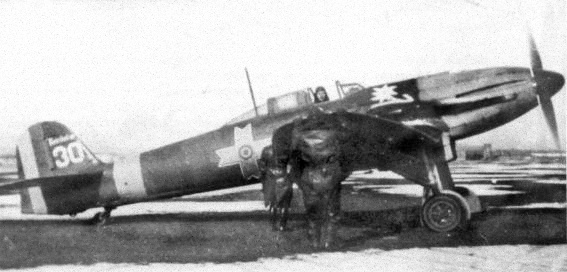
A regular He 112
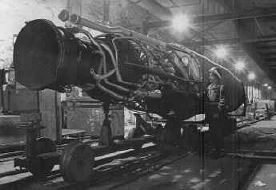
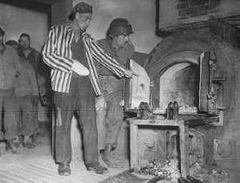
左、ドーラ収容所の地下工場、右、ドーラ収容所の奴隷労働(ユダヤ人)者用の死体焼却炉
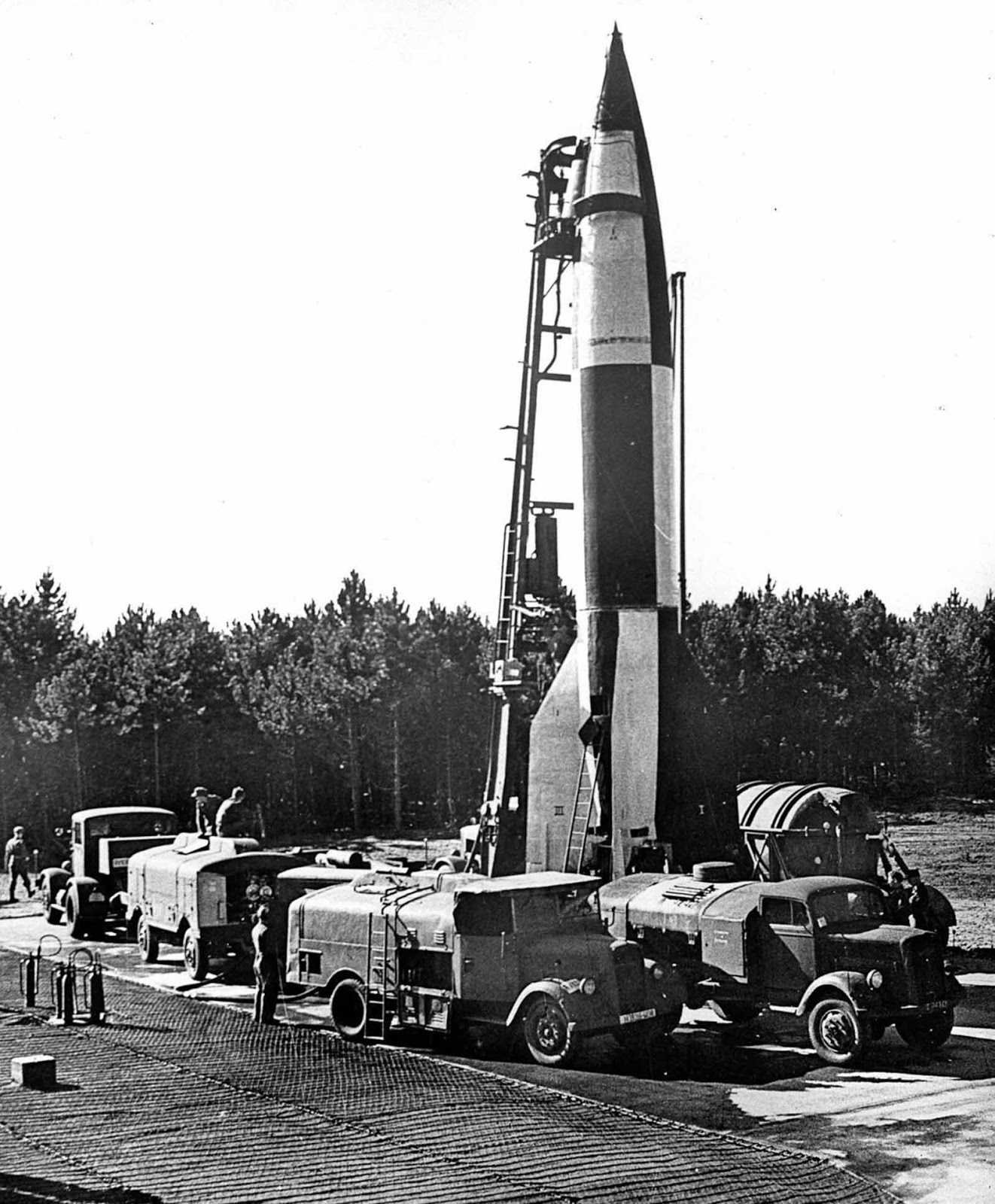
米国に渡ってきてからは、市民権を獲得するまでは、P. O. Box 1142 に収容された。
Schematic of the A4/V2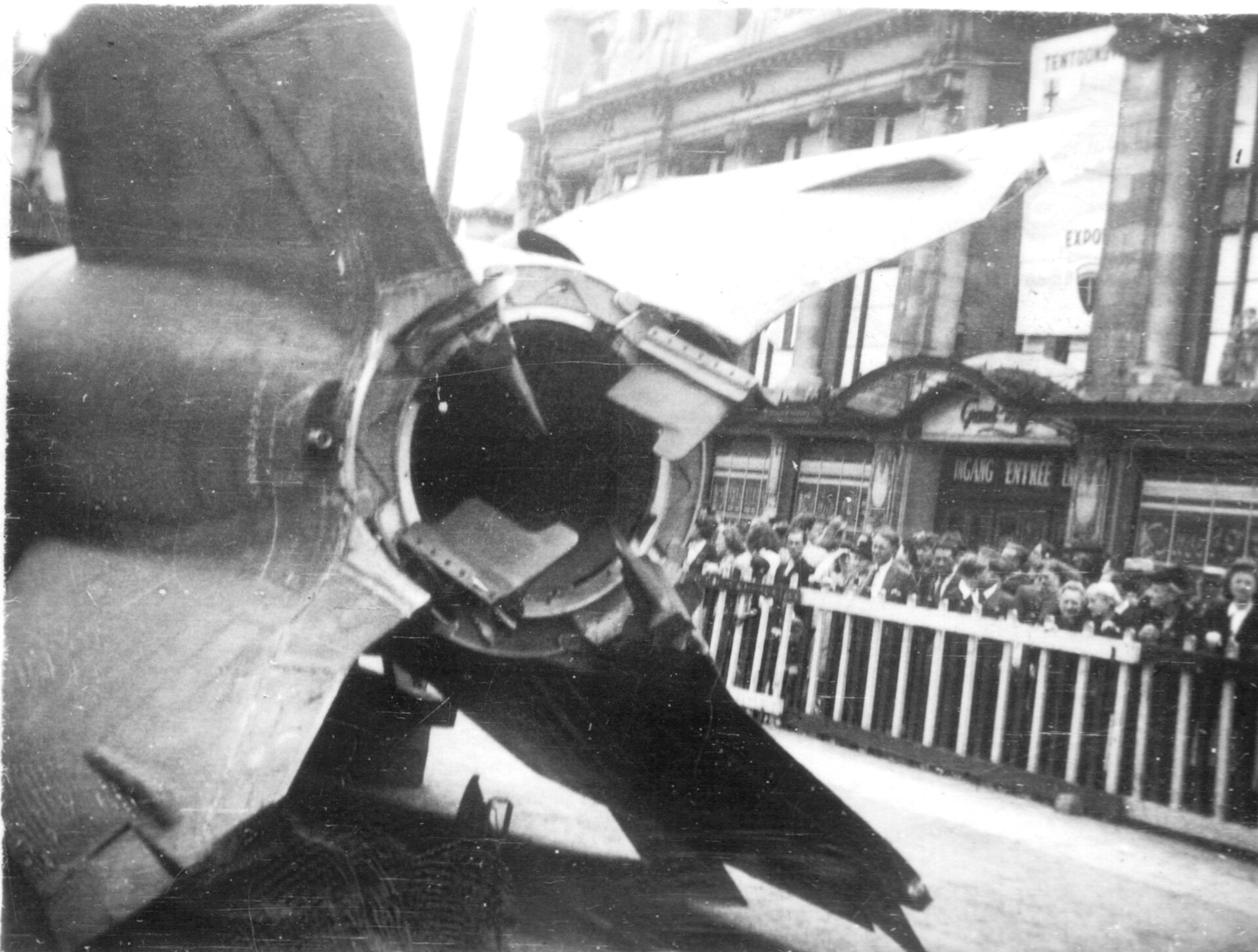
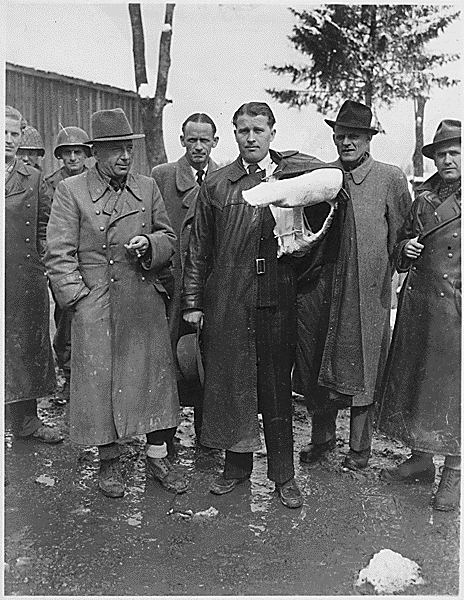
Von Braun, with his arm in a cast, Walter Dornberger (on the left) and Bernhard Tessmann (on the right) surrendered to the Americans just before this 3 May 1945 photo.
腕をギプスで固定されたフォン・ブラウン、ヴァルター・ドーンベルガー(左)、ベルンハルト・テスマン(右)は、この1945年5月3日の写真の直前にアメリカに降伏した。
Wernher von Braun at a meeting of NACA's Special Committee on Space Technology, 1958
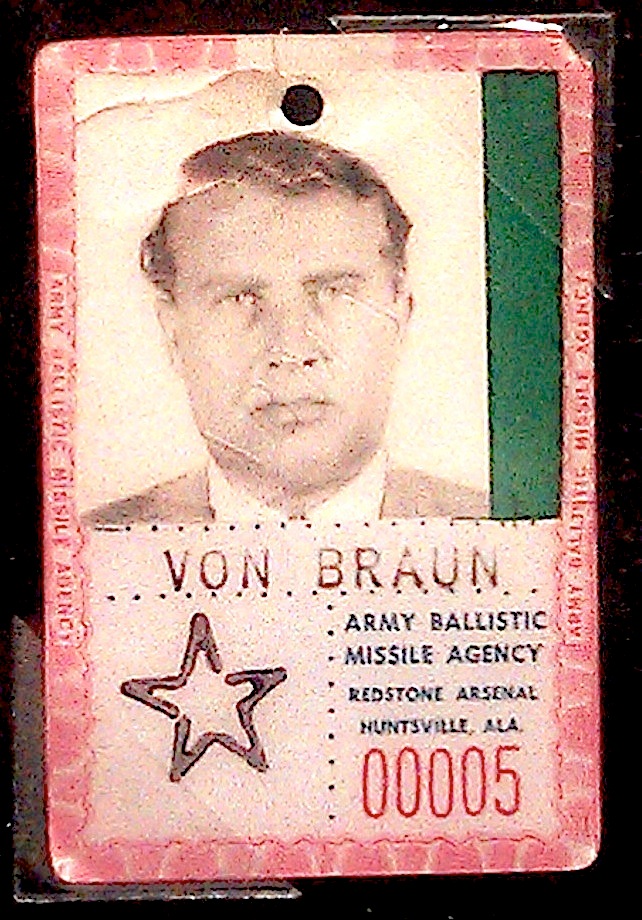
Von Braun's badge at ABMA (1957)
Von Braun with President Dwight D. Eisenhower, 1960; following the Sputnik crisis in 1957, the American leadership agreed to von Braun's main role in the design of space rockets
Walt Disney and von Braun, seen in 1954 holding a model of his passenger ship, collaborated on a series of three educational films; among other things, this suggests that von Braun had enough free time to popularize astronautics due to the fact that priority in the design of a space rocket was given to other people.[7]
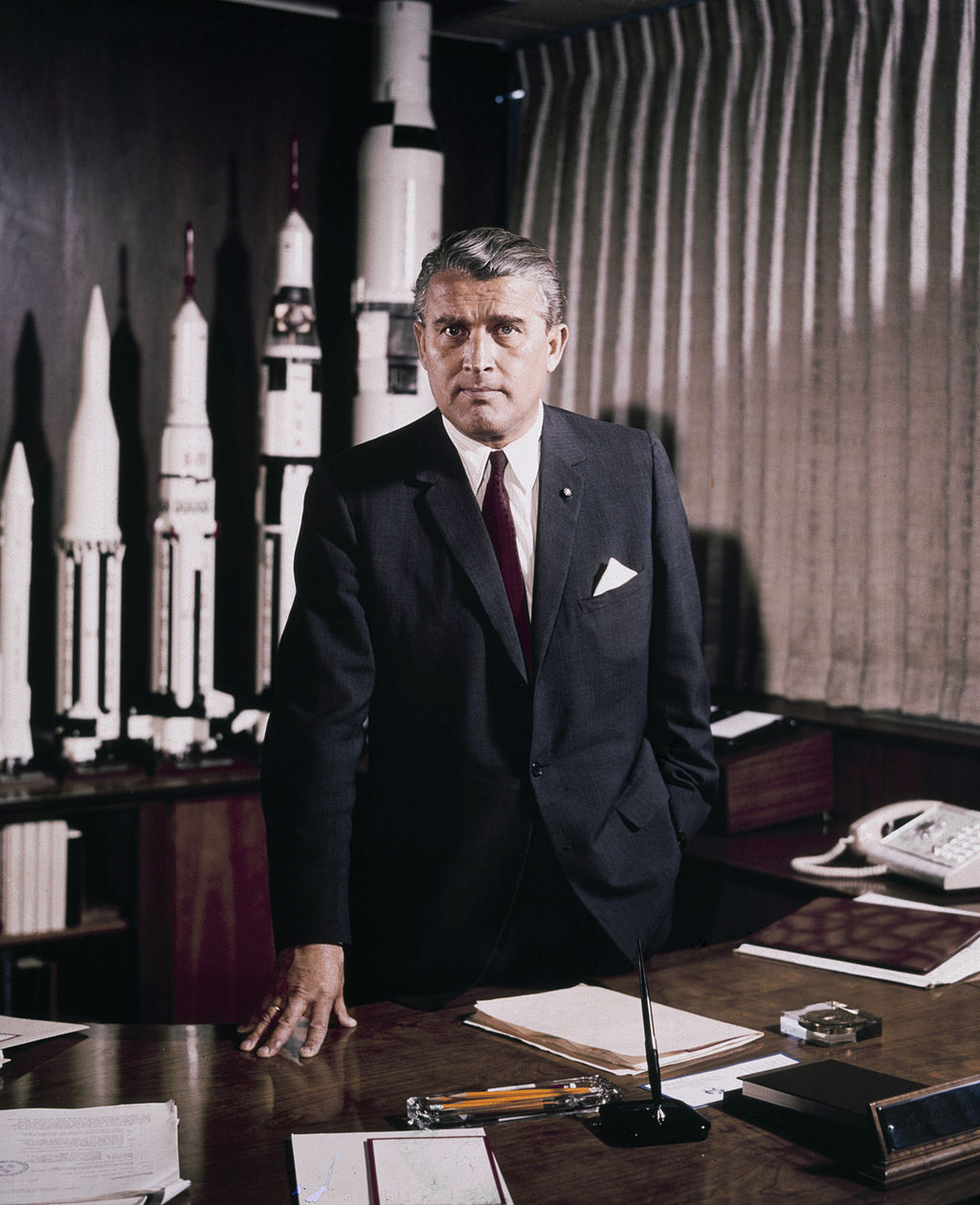
von Braun in his office with the rockets.
Von Braun with President Kennedy at Redstone Arsenal in 1963; President Kennedy was the initiator of the American lunar program in 1961, and von Braun was appointed its technical director.
Von Braun in his office at Marshall Space Flight Center.
In 1970,
Huntsville, Alabama, honored von Braun's years of service with a series
of events including the unveiling of a plaque in his honor. Pictured
(l–r), his daughter Iris, wife Maria, U.S. Sen. John Sparkman, Alabama
Gov. Albert Brewer, von Braun, son Peter, and daughter Margrit.
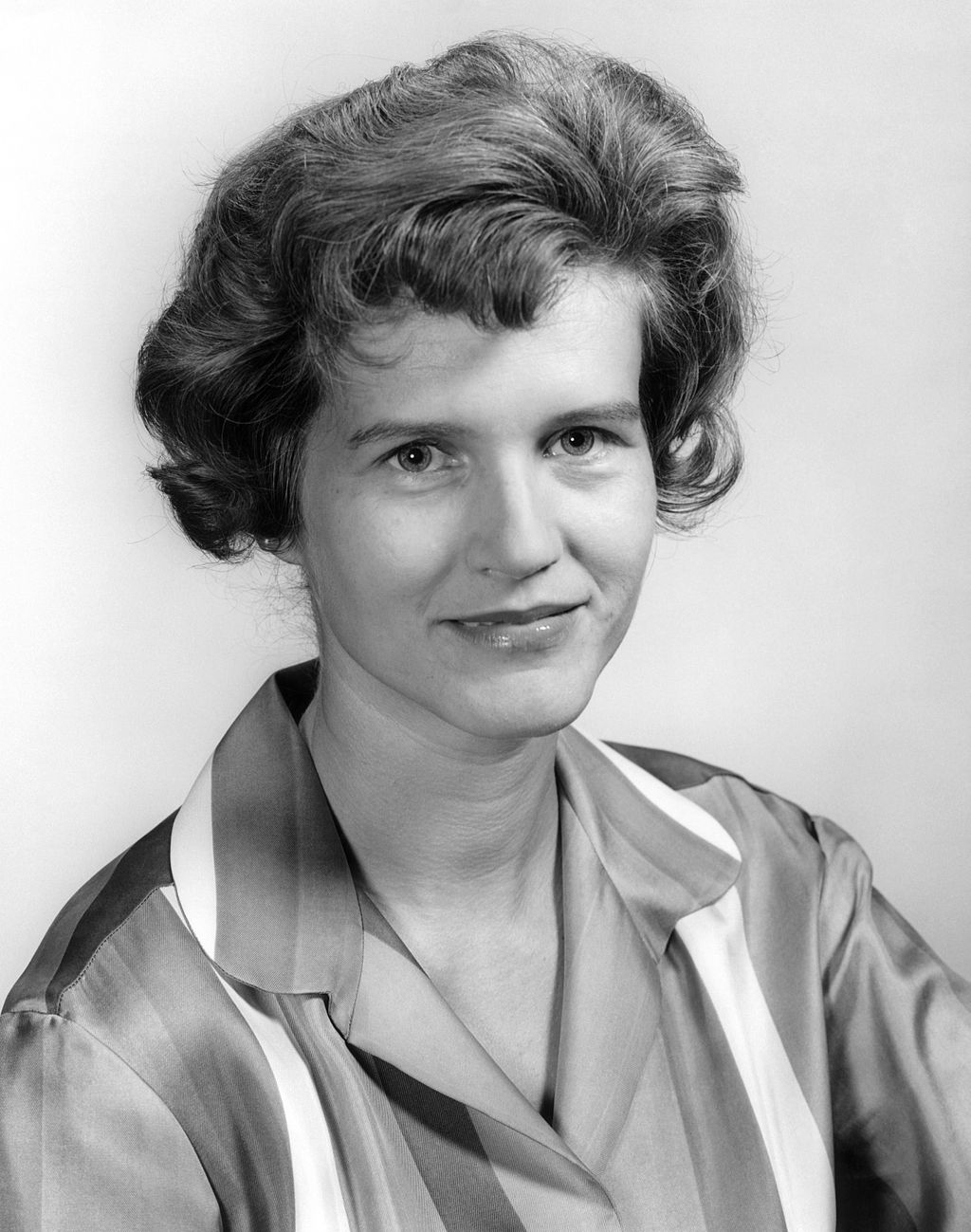
Maria von Braun
Grave of Wernher von Braun in Ivy Hill Cemetery (Alexandria, Virginia), 2008
++++++++++++
リンク
文献
その他の情報
Copyleft, CC, Mitzub'ixi Quq Chi'j, 1996-2099
Do not paste, but
[Re]Think our message for all undergraduate
students!!!